Design and Discussion Name Institution Assessment Design and Discussion
VerifiedAdded on 2021/06/15
|21
|5164
|227
AI Summary
Assessment Design and Discussion Name Institution Assessment design and discussion Introduction Teaching students a second language is often one of the most challenging tasks for teachers since time immemorial (Brassard et al., 2011). The majority of these students speak English as their second language, although a majority of the rest of the school speaks English as their first language. Language abilities/ability Language ability, also known as language proficiency, can be defined as the ability of an individual to write, speak or perform in a given language (
Contribute Materials
Your contribution can guide someone’s learning journey. Share your
documents today.
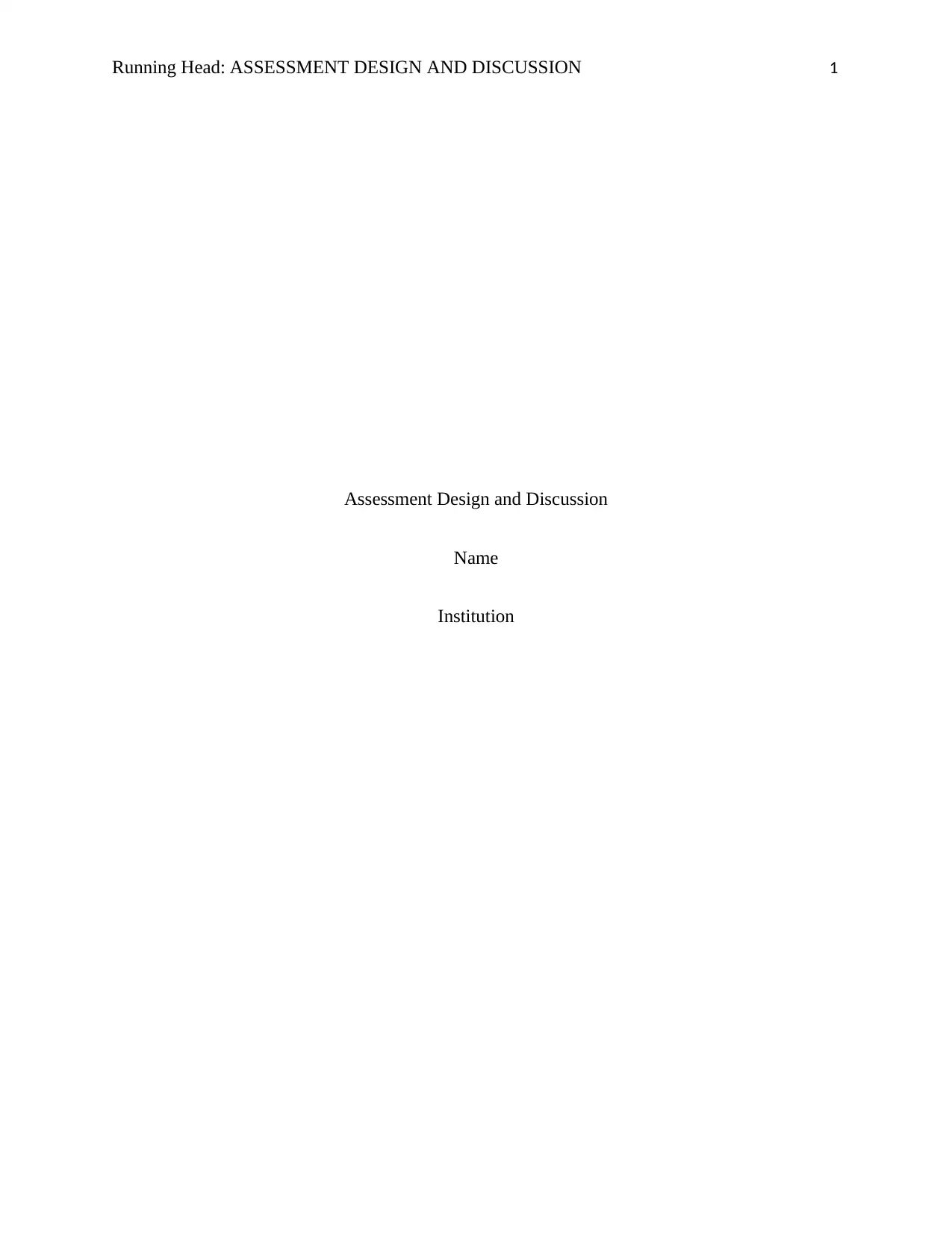
Running Head: ASSESSMENT DESIGN AND DISCUSSION 1
Assessment Design and Discussion
Name
Institution
Assessment Design and Discussion
Name
Institution
Secure Best Marks with AI Grader
Need help grading? Try our AI Grader for instant feedback on your assignments.
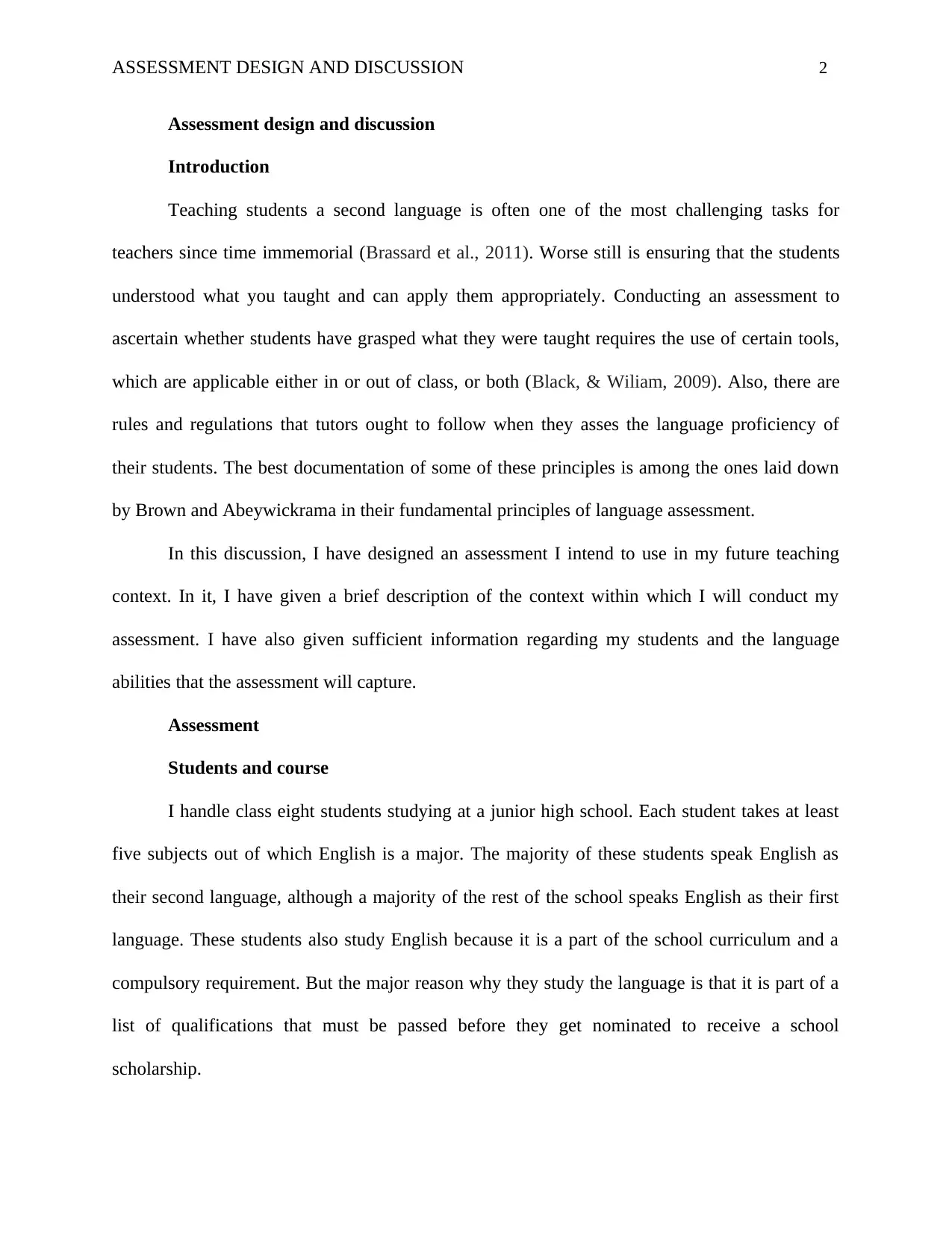
ASSESSMENT DESIGN AND DISCUSSION 2
Assessment design and discussion
Introduction
Teaching students a second language is often one of the most challenging tasks for
teachers since time immemorial (Brassard et al., 2011). Worse still is ensuring that the students
understood what you taught and can apply them appropriately. Conducting an assessment to
ascertain whether students have grasped what they were taught requires the use of certain tools,
which are applicable either in or out of class, or both (Black, & Wiliam, 2009). Also, there are
rules and regulations that tutors ought to follow when they asses the language proficiency of
their students. The best documentation of some of these principles is among the ones laid down
by Brown and Abeywickrama in their fundamental principles of language assessment.
In this discussion, I have designed an assessment I intend to use in my future teaching
context. In it, I have given a brief description of the context within which I will conduct my
assessment. I have also given sufficient information regarding my students and the language
abilities that the assessment will capture.
Assessment
Students and course
I handle class eight students studying at a junior high school. Each student takes at least
five subjects out of which English is a major. The majority of these students speak English as
their second language, although a majority of the rest of the school speaks English as their first
language. These students also study English because it is a part of the school curriculum and a
compulsory requirement. But the major reason why they study the language is that it is part of a
list of qualifications that must be passed before they get nominated to receive a school
scholarship.
Assessment design and discussion
Introduction
Teaching students a second language is often one of the most challenging tasks for
teachers since time immemorial (Brassard et al., 2011). Worse still is ensuring that the students
understood what you taught and can apply them appropriately. Conducting an assessment to
ascertain whether students have grasped what they were taught requires the use of certain tools,
which are applicable either in or out of class, or both (Black, & Wiliam, 2009). Also, there are
rules and regulations that tutors ought to follow when they asses the language proficiency of
their students. The best documentation of some of these principles is among the ones laid down
by Brown and Abeywickrama in their fundamental principles of language assessment.
In this discussion, I have designed an assessment I intend to use in my future teaching
context. In it, I have given a brief description of the context within which I will conduct my
assessment. I have also given sufficient information regarding my students and the language
abilities that the assessment will capture.
Assessment
Students and course
I handle class eight students studying at a junior high school. Each student takes at least
five subjects out of which English is a major. The majority of these students speak English as
their second language, although a majority of the rest of the school speaks English as their first
language. These students also study English because it is a part of the school curriculum and a
compulsory requirement. But the major reason why they study the language is that it is part of a
list of qualifications that must be passed before they get nominated to receive a school
scholarship.
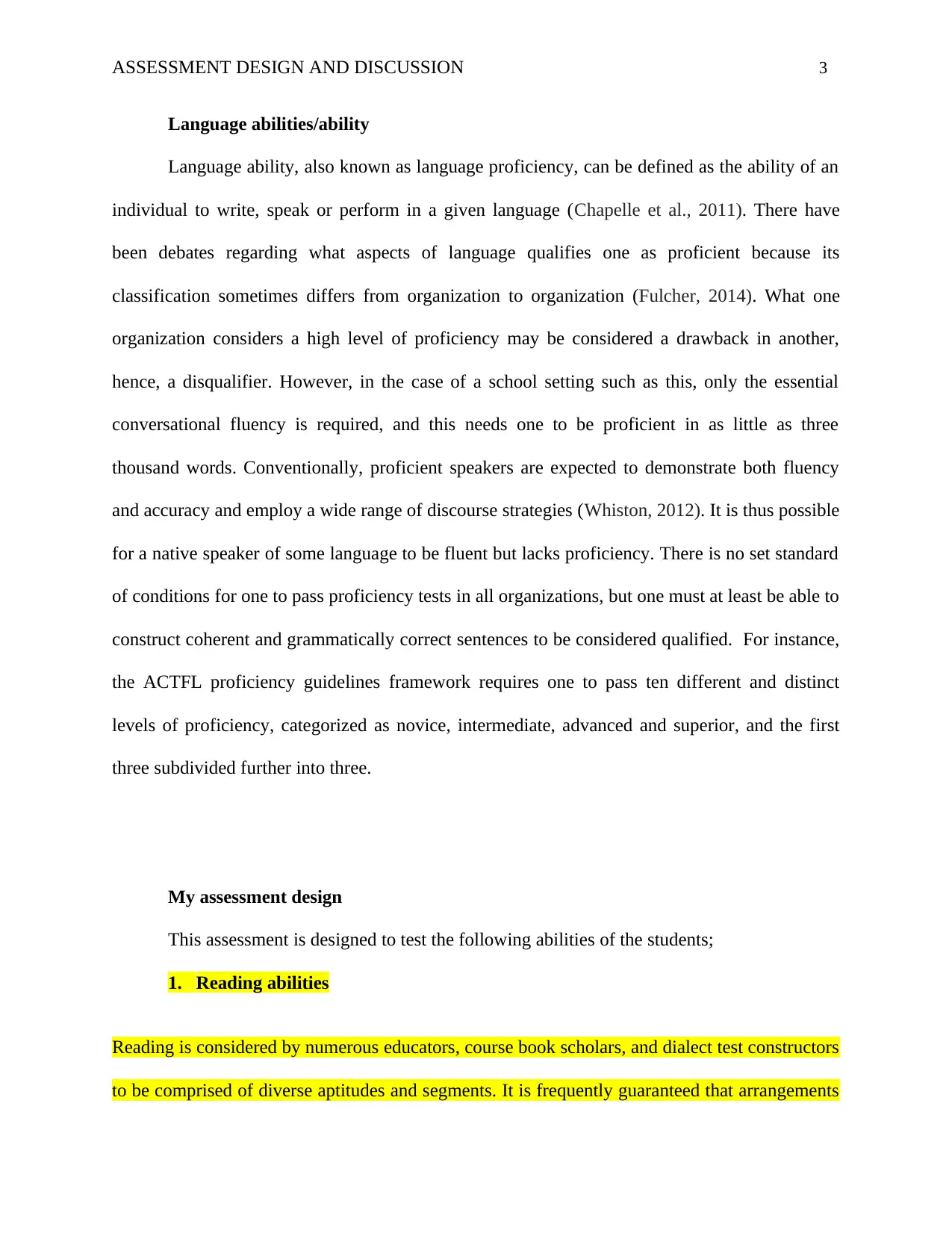
ASSESSMENT DESIGN AND DISCUSSION 3
Language abilities/ability
Language ability, also known as language proficiency, can be defined as the ability of an
individual to write, speak or perform in a given language (Chapelle et al., 2011). There have
been debates regarding what aspects of language qualifies one as proficient because its
classification sometimes differs from organization to organization (Fulcher, 2014). What one
organization considers a high level of proficiency may be considered a drawback in another,
hence, a disqualifier. However, in the case of a school setting such as this, only the essential
conversational fluency is required, and this needs one to be proficient in as little as three
thousand words. Conventionally, proficient speakers are expected to demonstrate both fluency
and accuracy and employ a wide range of discourse strategies (Whiston, 2012). It is thus possible
for a native speaker of some language to be fluent but lacks proficiency. There is no set standard
of conditions for one to pass proficiency tests in all organizations, but one must at least be able to
construct coherent and grammatically correct sentences to be considered qualified. For instance,
the ACTFL proficiency guidelines framework requires one to pass ten different and distinct
levels of proficiency, categorized as novice, intermediate, advanced and superior, and the first
three subdivided further into three.
My assessment design
This assessment is designed to test the following abilities of the students;
1. Reading abilities
Reading is considered by numerous educators, course book scholars, and dialect test constructors
to be comprised of diverse aptitudes and segments. It is frequently guaranteed that arrangements
Language abilities/ability
Language ability, also known as language proficiency, can be defined as the ability of an
individual to write, speak or perform in a given language (Chapelle et al., 2011). There have
been debates regarding what aspects of language qualifies one as proficient because its
classification sometimes differs from organization to organization (Fulcher, 2014). What one
organization considers a high level of proficiency may be considered a drawback in another,
hence, a disqualifier. However, in the case of a school setting such as this, only the essential
conversational fluency is required, and this needs one to be proficient in as little as three
thousand words. Conventionally, proficient speakers are expected to demonstrate both fluency
and accuracy and employ a wide range of discourse strategies (Whiston, 2012). It is thus possible
for a native speaker of some language to be fluent but lacks proficiency. There is no set standard
of conditions for one to pass proficiency tests in all organizations, but one must at least be able to
construct coherent and grammatically correct sentences to be considered qualified. For instance,
the ACTFL proficiency guidelines framework requires one to pass ten different and distinct
levels of proficiency, categorized as novice, intermediate, advanced and superior, and the first
three subdivided further into three.
My assessment design
This assessment is designed to test the following abilities of the students;
1. Reading abilities
Reading is considered by numerous educators, course book scholars, and dialect test constructors
to be comprised of diverse aptitudes and segments. It is frequently guaranteed that arrangements
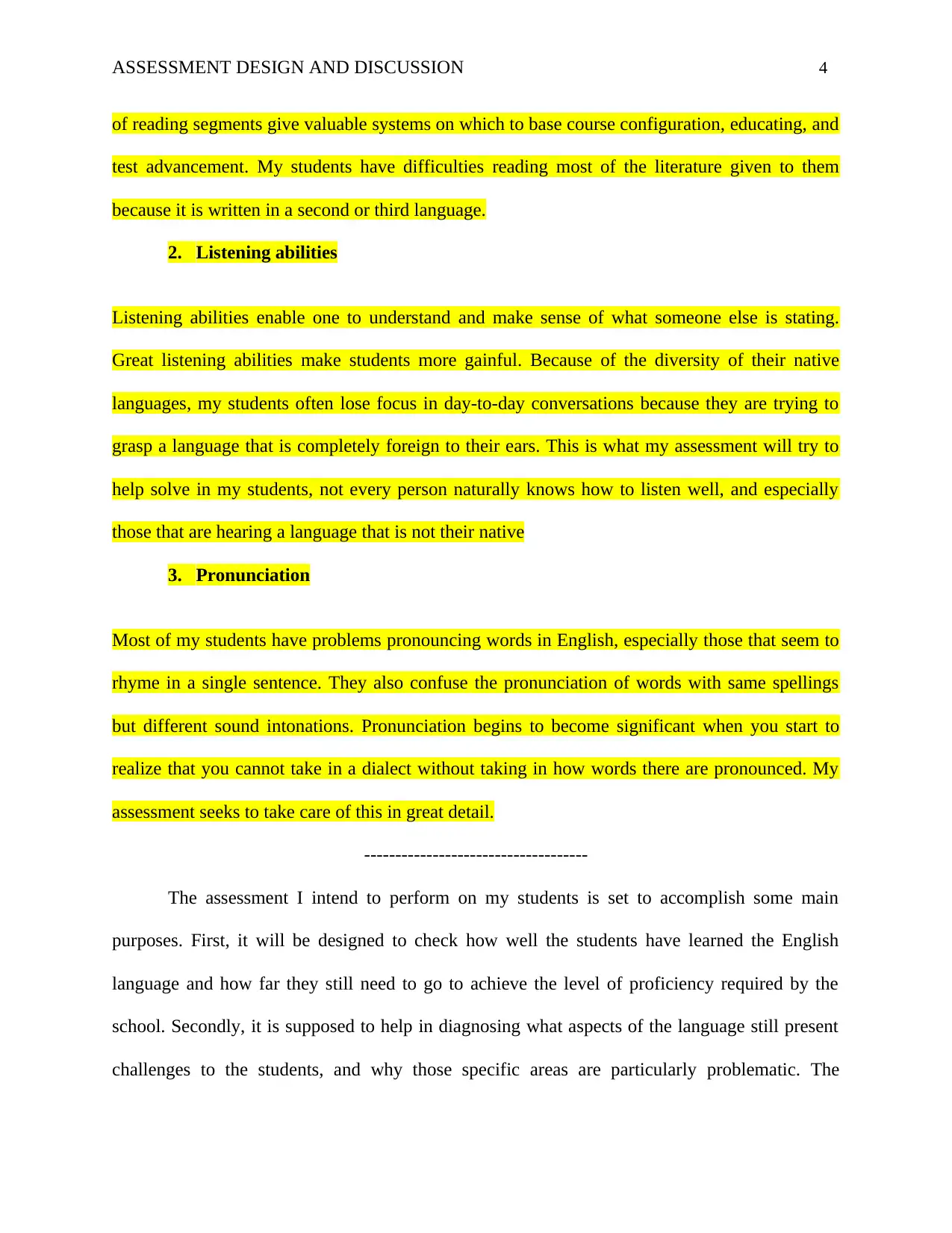
ASSESSMENT DESIGN AND DISCUSSION 4
of reading segments give valuable systems on which to base course configuration, educating, and
test advancement. My students have difficulties reading most of the literature given to them
because it is written in a second or third language.
2. Listening abilities
Listening abilities enable one to understand and make sense of what someone else is stating.
Great listening abilities make students more gainful. Because of the diversity of their native
languages, my students often lose focus in day-to-day conversations because they are trying to
grasp a language that is completely foreign to their ears. This is what my assessment will try to
help solve in my students, not every person naturally knows how to listen well, and especially
those that are hearing a language that is not their native
3. Pronunciation
Most of my students have problems pronouncing words in English, especially those that seem to
rhyme in a single sentence. They also confuse the pronunciation of words with same spellings
but different sound intonations. Pronunciation begins to become significant when you start to
realize that you cannot take in a dialect without taking in how words there are pronounced. My
assessment seeks to take care of this in great detail.
------------------------------------
The assessment I intend to perform on my students is set to accomplish some main
purposes. First, it will be designed to check how well the students have learned the English
language and how far they still need to go to achieve the level of proficiency required by the
school. Secondly, it is supposed to help in diagnosing what aspects of the language still present
challenges to the students, and why those specific areas are particularly problematic. The
of reading segments give valuable systems on which to base course configuration, educating, and
test advancement. My students have difficulties reading most of the literature given to them
because it is written in a second or third language.
2. Listening abilities
Listening abilities enable one to understand and make sense of what someone else is stating.
Great listening abilities make students more gainful. Because of the diversity of their native
languages, my students often lose focus in day-to-day conversations because they are trying to
grasp a language that is completely foreign to their ears. This is what my assessment will try to
help solve in my students, not every person naturally knows how to listen well, and especially
those that are hearing a language that is not their native
3. Pronunciation
Most of my students have problems pronouncing words in English, especially those that seem to
rhyme in a single sentence. They also confuse the pronunciation of words with same spellings
but different sound intonations. Pronunciation begins to become significant when you start to
realize that you cannot take in a dialect without taking in how words there are pronounced. My
assessment seeks to take care of this in great detail.
------------------------------------
The assessment I intend to perform on my students is set to accomplish some main
purposes. First, it will be designed to check how well the students have learned the English
language and how far they still need to go to achieve the level of proficiency required by the
school. Secondly, it is supposed to help in diagnosing what aspects of the language still present
challenges to the students, and why those specific areas are particularly problematic. The
Secure Best Marks with AI Grader
Need help grading? Try our AI Grader for instant feedback on your assignments.
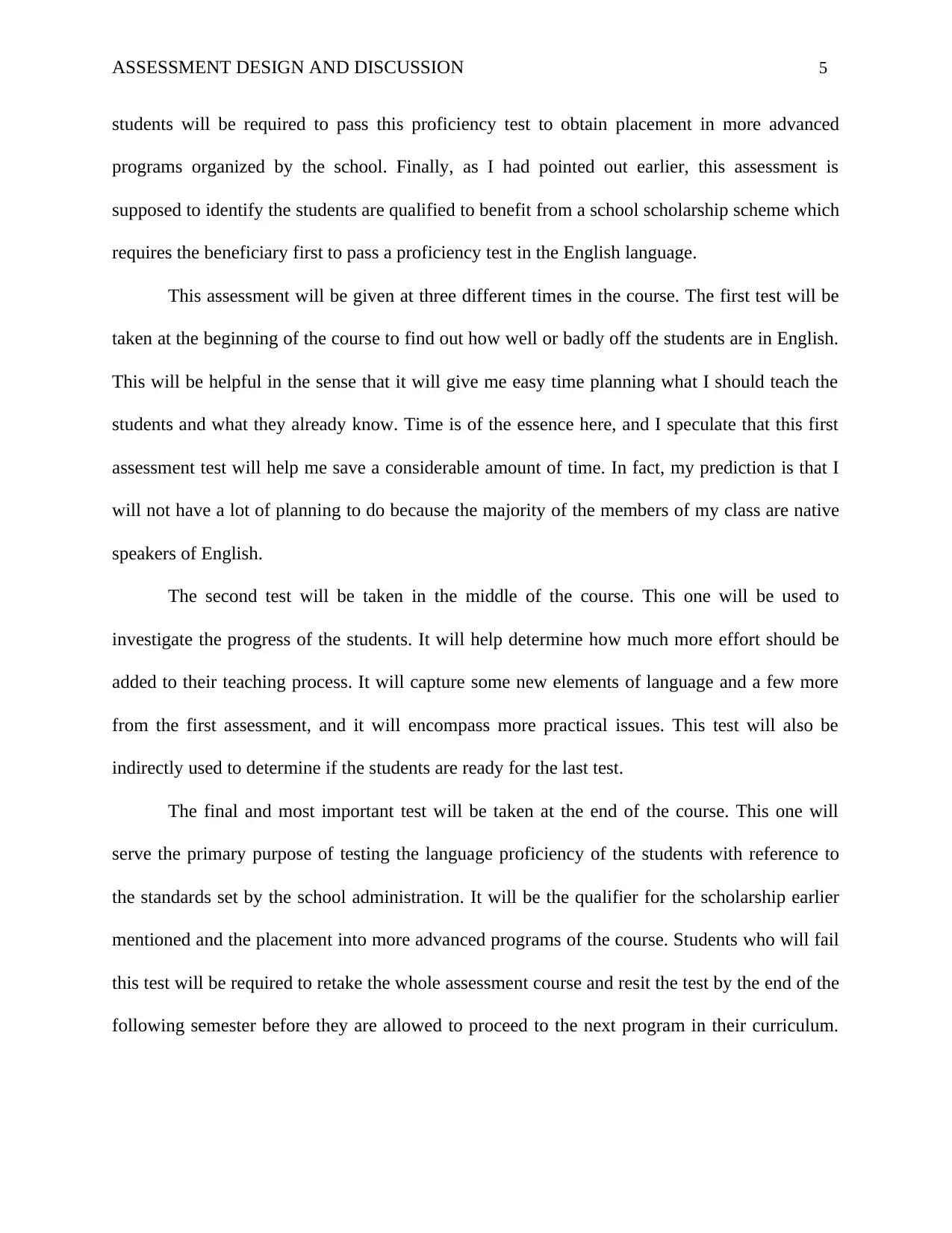
ASSESSMENT DESIGN AND DISCUSSION 5
students will be required to pass this proficiency test to obtain placement in more advanced
programs organized by the school. Finally, as I had pointed out earlier, this assessment is
supposed to identify the students are qualified to benefit from a school scholarship scheme which
requires the beneficiary first to pass a proficiency test in the English language.
This assessment will be given at three different times in the course. The first test will be
taken at the beginning of the course to find out how well or badly off the students are in English.
This will be helpful in the sense that it will give me easy time planning what I should teach the
students and what they already know. Time is of the essence here, and I speculate that this first
assessment test will help me save a considerable amount of time. In fact, my prediction is that I
will not have a lot of planning to do because the majority of the members of my class are native
speakers of English.
The second test will be taken in the middle of the course. This one will be used to
investigate the progress of the students. It will help determine how much more effort should be
added to their teaching process. It will capture some new elements of language and a few more
from the first assessment, and it will encompass more practical issues. This test will also be
indirectly used to determine if the students are ready for the last test.
The final and most important test will be taken at the end of the course. This one will
serve the primary purpose of testing the language proficiency of the students with reference to
the standards set by the school administration. It will be the qualifier for the scholarship earlier
mentioned and the placement into more advanced programs of the course. Students who will fail
this test will be required to retake the whole assessment course and resit the test by the end of the
following semester before they are allowed to proceed to the next program in their curriculum.
students will be required to pass this proficiency test to obtain placement in more advanced
programs organized by the school. Finally, as I had pointed out earlier, this assessment is
supposed to identify the students are qualified to benefit from a school scholarship scheme which
requires the beneficiary first to pass a proficiency test in the English language.
This assessment will be given at three different times in the course. The first test will be
taken at the beginning of the course to find out how well or badly off the students are in English.
This will be helpful in the sense that it will give me easy time planning what I should teach the
students and what they already know. Time is of the essence here, and I speculate that this first
assessment test will help me save a considerable amount of time. In fact, my prediction is that I
will not have a lot of planning to do because the majority of the members of my class are native
speakers of English.
The second test will be taken in the middle of the course. This one will be used to
investigate the progress of the students. It will help determine how much more effort should be
added to their teaching process. It will capture some new elements of language and a few more
from the first assessment, and it will encompass more practical issues. This test will also be
indirectly used to determine if the students are ready for the last test.
The final and most important test will be taken at the end of the course. This one will
serve the primary purpose of testing the language proficiency of the students with reference to
the standards set by the school administration. It will be the qualifier for the scholarship earlier
mentioned and the placement into more advanced programs of the course. Students who will fail
this test will be required to retake the whole assessment course and resit the test by the end of the
following semester before they are allowed to proceed to the next program in their curriculum.
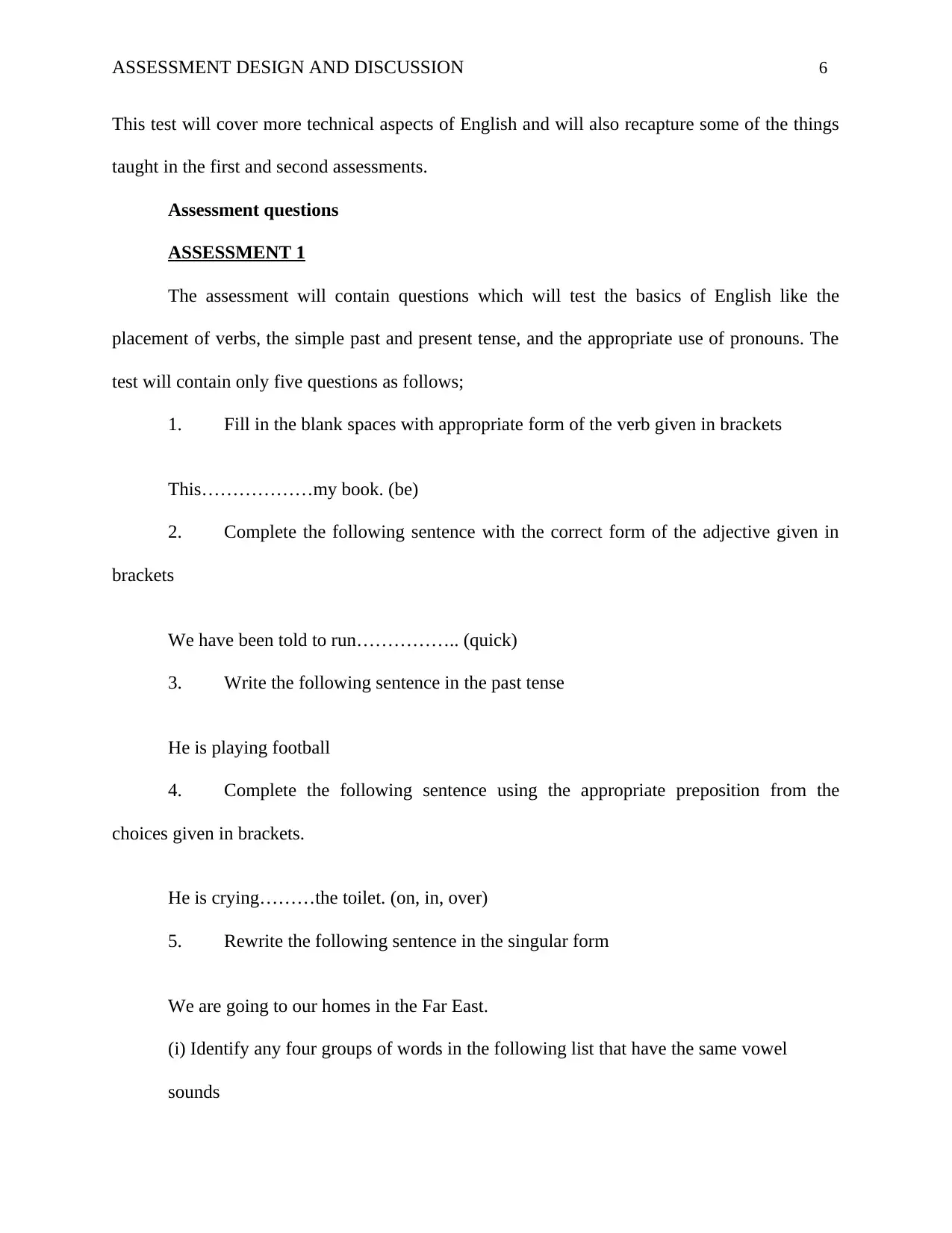
ASSESSMENT DESIGN AND DISCUSSION 6
This test will cover more technical aspects of English and will also recapture some of the things
taught in the first and second assessments.
Assessment questions
ASSESSMENT 1
The assessment will contain questions which will test the basics of English like the
placement of verbs, the simple past and present tense, and the appropriate use of pronouns. The
test will contain only five questions as follows;
1. Fill in the blank spaces with appropriate form of the verb given in brackets
This………………my book. (be)
2. Complete the following sentence with the correct form of the adjective given in
brackets
We have been told to run…………….. (quick)
3. Write the following sentence in the past tense
He is playing football
4. Complete the following sentence using the appropriate preposition from the
choices given in brackets.
He is crying………the toilet. (on, in, over)
5. Rewrite the following sentence in the singular form
We are going to our homes in the Far East.
(i) Identify any four groups of words in the following list that have the same vowel
sounds
This test will cover more technical aspects of English and will also recapture some of the things
taught in the first and second assessments.
Assessment questions
ASSESSMENT 1
The assessment will contain questions which will test the basics of English like the
placement of verbs, the simple past and present tense, and the appropriate use of pronouns. The
test will contain only five questions as follows;
1. Fill in the blank spaces with appropriate form of the verb given in brackets
This………………my book. (be)
2. Complete the following sentence with the correct form of the adjective given in
brackets
We have been told to run…………….. (quick)
3. Write the following sentence in the past tense
He is playing football
4. Complete the following sentence using the appropriate preposition from the
choices given in brackets.
He is crying………the toilet. (on, in, over)
5. Rewrite the following sentence in the singular form
We are going to our homes in the Far East.
(i) Identify any four groups of words in the following list that have the same vowel
sounds
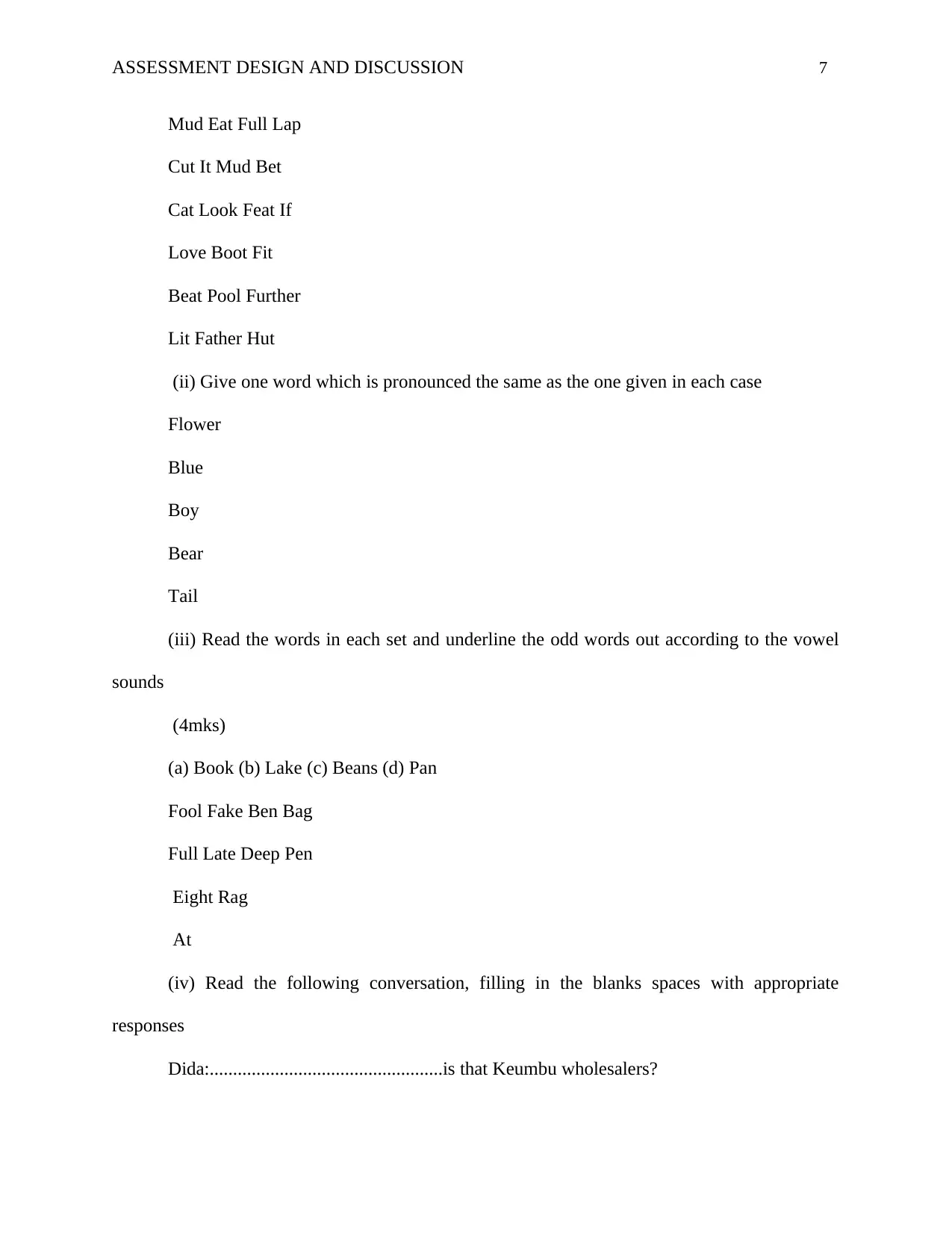
ASSESSMENT DESIGN AND DISCUSSION 7
Mud Eat Full Lap
Cut It Mud Bet
Cat Look Feat If
Love Boot Fit
Beat Pool Further
Lit Father Hut
(ii) Give one word which is pronounced the same as the one given in each case
Flower
Blue
Boy
Bear
Tail
(iii) Read the words in each set and underline the odd words out according to the vowel
sounds
(4mks)
(a) Book (b) Lake (c) Beans (d) Pan
Fool Fake Ben Bag
Full Late Deep Pen
Eight Rag
At
(iv) Read the following conversation, filling in the blanks spaces with appropriate
responses
Dida:..................................................is that Keumbu wholesalers?
Mud Eat Full Lap
Cut It Mud Bet
Cat Look Feat If
Love Boot Fit
Beat Pool Further
Lit Father Hut
(ii) Give one word which is pronounced the same as the one given in each case
Flower
Blue
Boy
Bear
Tail
(iii) Read the words in each set and underline the odd words out according to the vowel
sounds
(4mks)
(a) Book (b) Lake (c) Beans (d) Pan
Fool Fake Ben Bag
Full Late Deep Pen
Eight Rag
At
(iv) Read the following conversation, filling in the blanks spaces with appropriate
responses
Dida:..................................................is that Keumbu wholesalers?
Paraphrase This Document
Need a fresh take? Get an instant paraphrase of this document with our AI Paraphraser
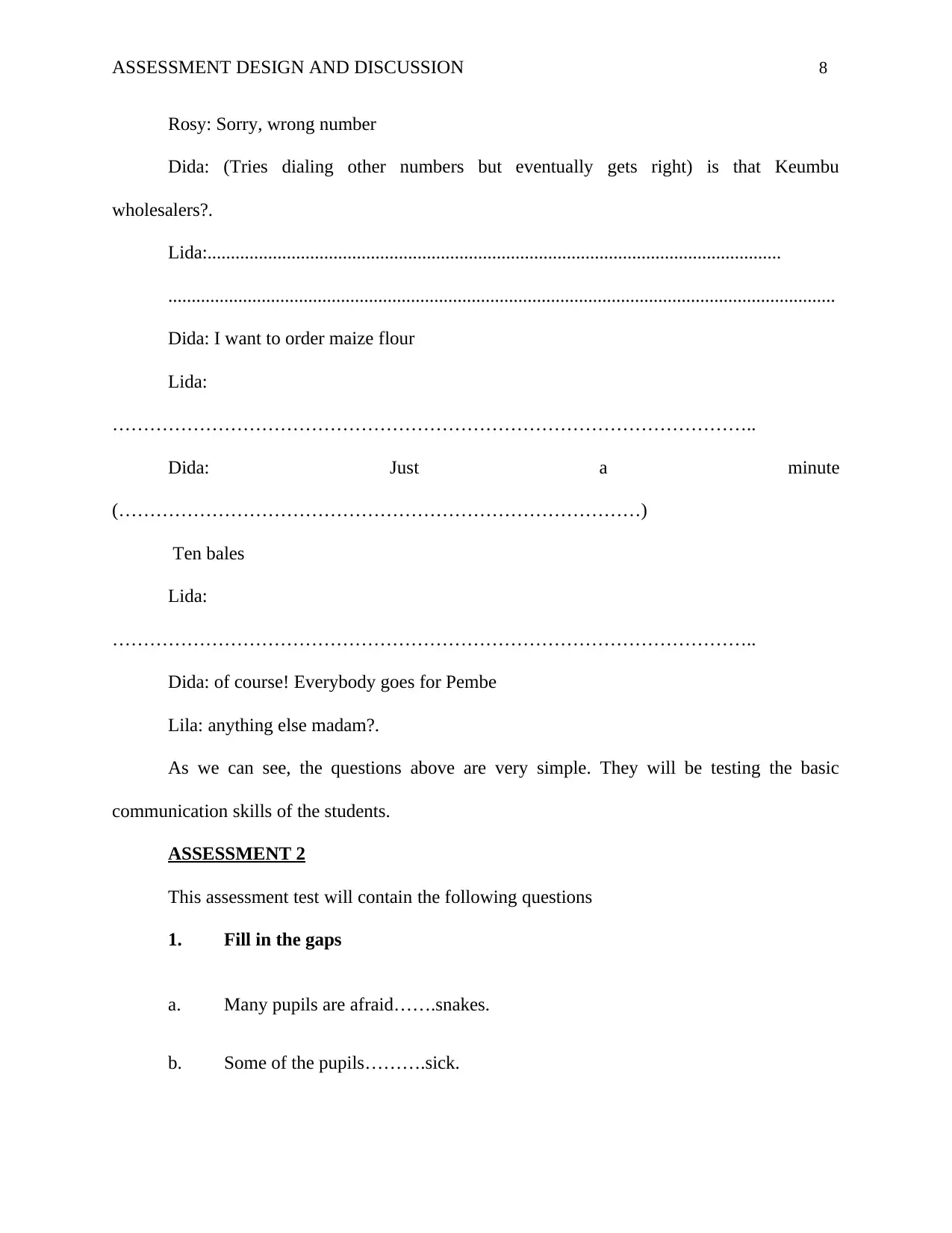
ASSESSMENT DESIGN AND DISCUSSION 8
Rosy: Sorry, wrong number
Dida: (Tries dialing other numbers but eventually gets right) is that Keumbu
wholesalers?.
Lida:...........................................................................................................................
...............................................................................................................................................
Dida: I want to order maize flour
Lida:
…………………………………………………………………………………………..
Dida: Just a minute
(…………………………………………………………………………)
Ten bales
Lida:
…………………………………………………………………………………………..
Dida: of course! Everybody goes for Pembe
Lila: anything else madam?.
As we can see, the questions above are very simple. They will be testing the basic
communication skills of the students.
ASSESSMENT 2
This assessment test will contain the following questions
1. Fill in the gaps
a. Many pupils are afraid…….snakes.
b. Some of the pupils……….sick.
Rosy: Sorry, wrong number
Dida: (Tries dialing other numbers but eventually gets right) is that Keumbu
wholesalers?.
Lida:...........................................................................................................................
...............................................................................................................................................
Dida: I want to order maize flour
Lida:
…………………………………………………………………………………………..
Dida: Just a minute
(…………………………………………………………………………)
Ten bales
Lida:
…………………………………………………………………………………………..
Dida: of course! Everybody goes for Pembe
Lila: anything else madam?.
As we can see, the questions above are very simple. They will be testing the basic
communication skills of the students.
ASSESSMENT 2
This assessment test will contain the following questions
1. Fill in the gaps
a. Many pupils are afraid…….snakes.
b. Some of the pupils……….sick.
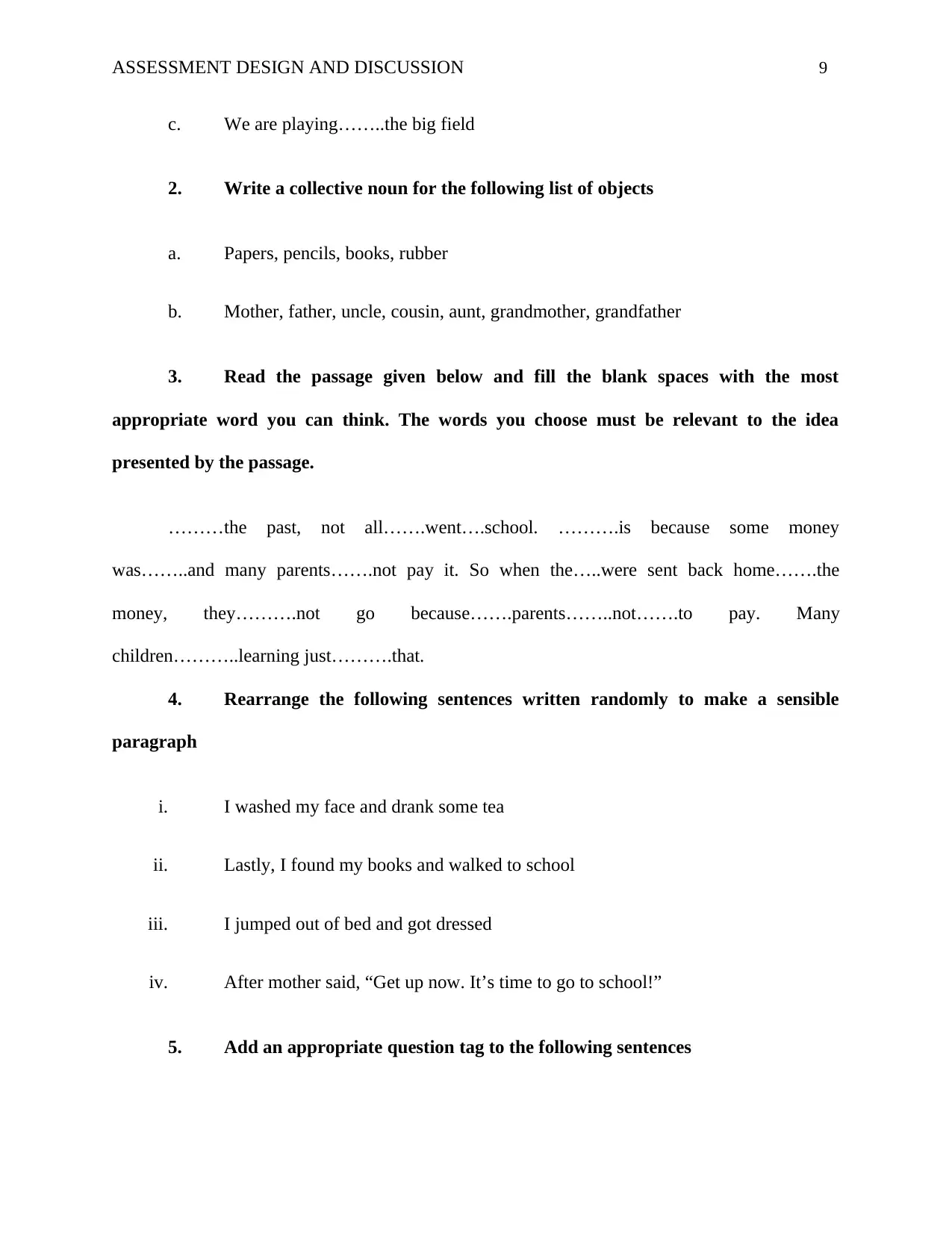
ASSESSMENT DESIGN AND DISCUSSION 9
c. We are playing……..the big field
2. Write a collective noun for the following list of objects
a. Papers, pencils, books, rubber
b. Mother, father, uncle, cousin, aunt, grandmother, grandfather
3. Read the passage given below and fill the blank spaces with the most
appropriate word you can think. The words you choose must be relevant to the idea
presented by the passage.
………the past, not all…….went….school. ……….is because some money
was……..and many parents…….not pay it. So when the…..were sent back home…….the
money, they……….not go because…….parents……..not…….to pay. Many
children………..learning just……….that.
4. Rearrange the following sentences written randomly to make a sensible
paragraph
i. I washed my face and drank some tea
ii. Lastly, I found my books and walked to school
iii. I jumped out of bed and got dressed
iv. After mother said, “Get up now. It’s time to go to school!”
5. Add an appropriate question tag to the following sentences
c. We are playing……..the big field
2. Write a collective noun for the following list of objects
a. Papers, pencils, books, rubber
b. Mother, father, uncle, cousin, aunt, grandmother, grandfather
3. Read the passage given below and fill the blank spaces with the most
appropriate word you can think. The words you choose must be relevant to the idea
presented by the passage.
………the past, not all…….went….school. ……….is because some money
was……..and many parents…….not pay it. So when the…..were sent back home…….the
money, they……….not go because…….parents……..not…….to pay. Many
children………..learning just……….that.
4. Rearrange the following sentences written randomly to make a sensible
paragraph
i. I washed my face and drank some tea
ii. Lastly, I found my books and walked to school
iii. I jumped out of bed and got dressed
iv. After mother said, “Get up now. It’s time to go to school!”
5. Add an appropriate question tag to the following sentences
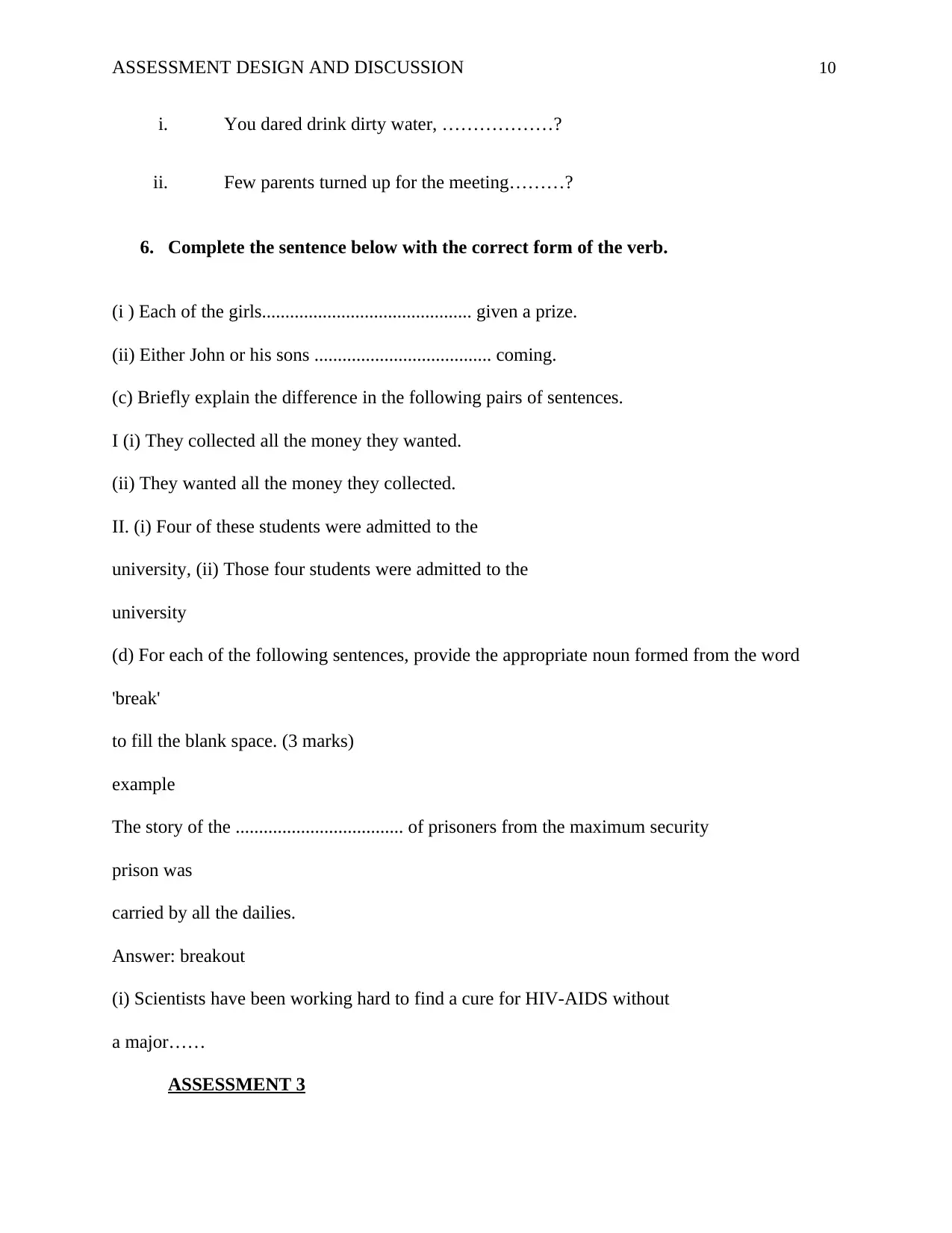
ASSESSMENT DESIGN AND DISCUSSION 10
i. You dared drink dirty water, ………………?
ii. Few parents turned up for the meeting………?
6. Complete the sentence below with the correct form of the verb.
(i ) Each of the girls............................................. given a prize.
(ii) Either John or his sons ...................................... coming.
(c) Briefly explain the difference in the following pairs of sentences.
I (i) They collected all the money they wanted.
(ii) They wanted all the money they collected.
II. (i) Four of these students were admitted to the
university, (ii) Those four students were admitted to the
university
(d) For each of the following sentences, provide the appropriate noun formed from the word
'break'
to fill the blank space. (3 marks)
example
The story of the .................................... of prisoners from the maximum security
prison was
carried by all the dailies.
Answer: breakout
(i) Scientists have been working hard to find a cure for HIV-AIDS without
a major……
ASSESSMENT 3
i. You dared drink dirty water, ………………?
ii. Few parents turned up for the meeting………?
6. Complete the sentence below with the correct form of the verb.
(i ) Each of the girls............................................. given a prize.
(ii) Either John or his sons ...................................... coming.
(c) Briefly explain the difference in the following pairs of sentences.
I (i) They collected all the money they wanted.
(ii) They wanted all the money they collected.
II. (i) Four of these students were admitted to the
university, (ii) Those four students were admitted to the
university
(d) For each of the following sentences, provide the appropriate noun formed from the word
'break'
to fill the blank space. (3 marks)
example
The story of the .................................... of prisoners from the maximum security
prison was
carried by all the dailies.
Answer: breakout
(i) Scientists have been working hard to find a cure for HIV-AIDS without
a major……
ASSESSMENT 3
Secure Best Marks with AI Grader
Need help grading? Try our AI Grader for instant feedback on your assignments.
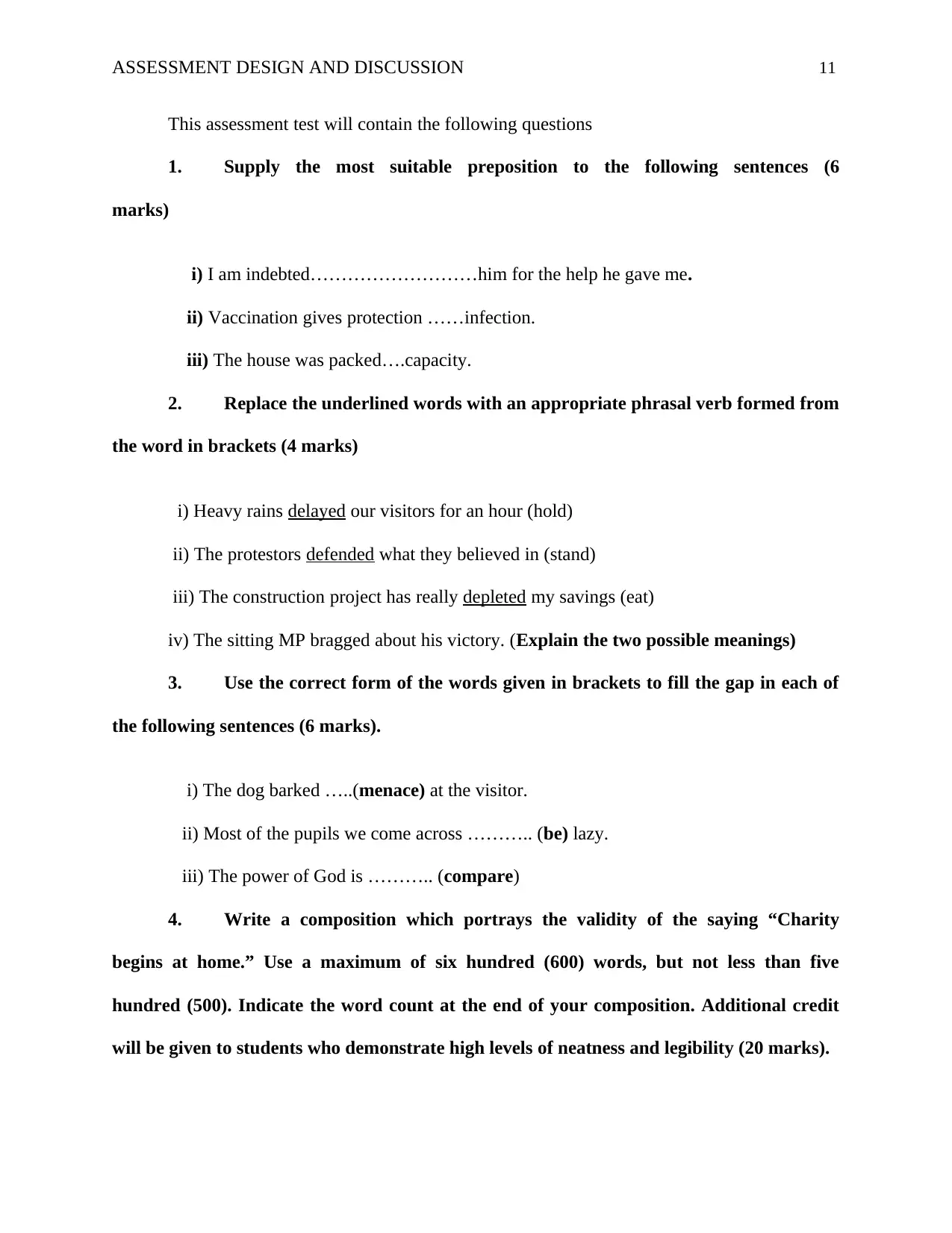
ASSESSMENT DESIGN AND DISCUSSION 11
This assessment test will contain the following questions
1. Supply the most suitable preposition to the following sentences (6
marks)
i) I am indebted………………………him for the help he gave me.
ii) Vaccination gives protection ……infection.
iii) The house was packed….capacity.
2. Replace the underlined words with an appropriate phrasal verb formed from
the word in brackets (4 marks)
i) Heavy rains delayed our visitors for an hour (hold)
ii) The protestors defended what they believed in (stand)
iii) The construction project has really depleted my savings (eat)
iv) The sitting MP bragged about his victory. (Explain the two possible meanings)
3. Use the correct form of the words given in brackets to fill the gap in each of
the following sentences (6 marks).
i) The dog barked …..(menace) at the visitor.
ii) Most of the pupils we come across ……….. (be) lazy.
iii) The power of God is ……….. (compare)
4. Write a composition which portrays the validity of the saying “Charity
begins at home.” Use a maximum of six hundred (600) words, but not less than five
hundred (500). Indicate the word count at the end of your composition. Additional credit
will be given to students who demonstrate high levels of neatness and legibility (20 marks).
This assessment test will contain the following questions
1. Supply the most suitable preposition to the following sentences (6
marks)
i) I am indebted………………………him for the help he gave me.
ii) Vaccination gives protection ……infection.
iii) The house was packed….capacity.
2. Replace the underlined words with an appropriate phrasal verb formed from
the word in brackets (4 marks)
i) Heavy rains delayed our visitors for an hour (hold)
ii) The protestors defended what they believed in (stand)
iii) The construction project has really depleted my savings (eat)
iv) The sitting MP bragged about his victory. (Explain the two possible meanings)
3. Use the correct form of the words given in brackets to fill the gap in each of
the following sentences (6 marks).
i) The dog barked …..(menace) at the visitor.
ii) Most of the pupils we come across ……….. (be) lazy.
iii) The power of God is ……….. (compare)
4. Write a composition which portrays the validity of the saying “Charity
begins at home.” Use a maximum of six hundred (600) words, but not less than five
hundred (500). Indicate the word count at the end of your composition. Additional credit
will be given to students who demonstrate high levels of neatness and legibility (20 marks).
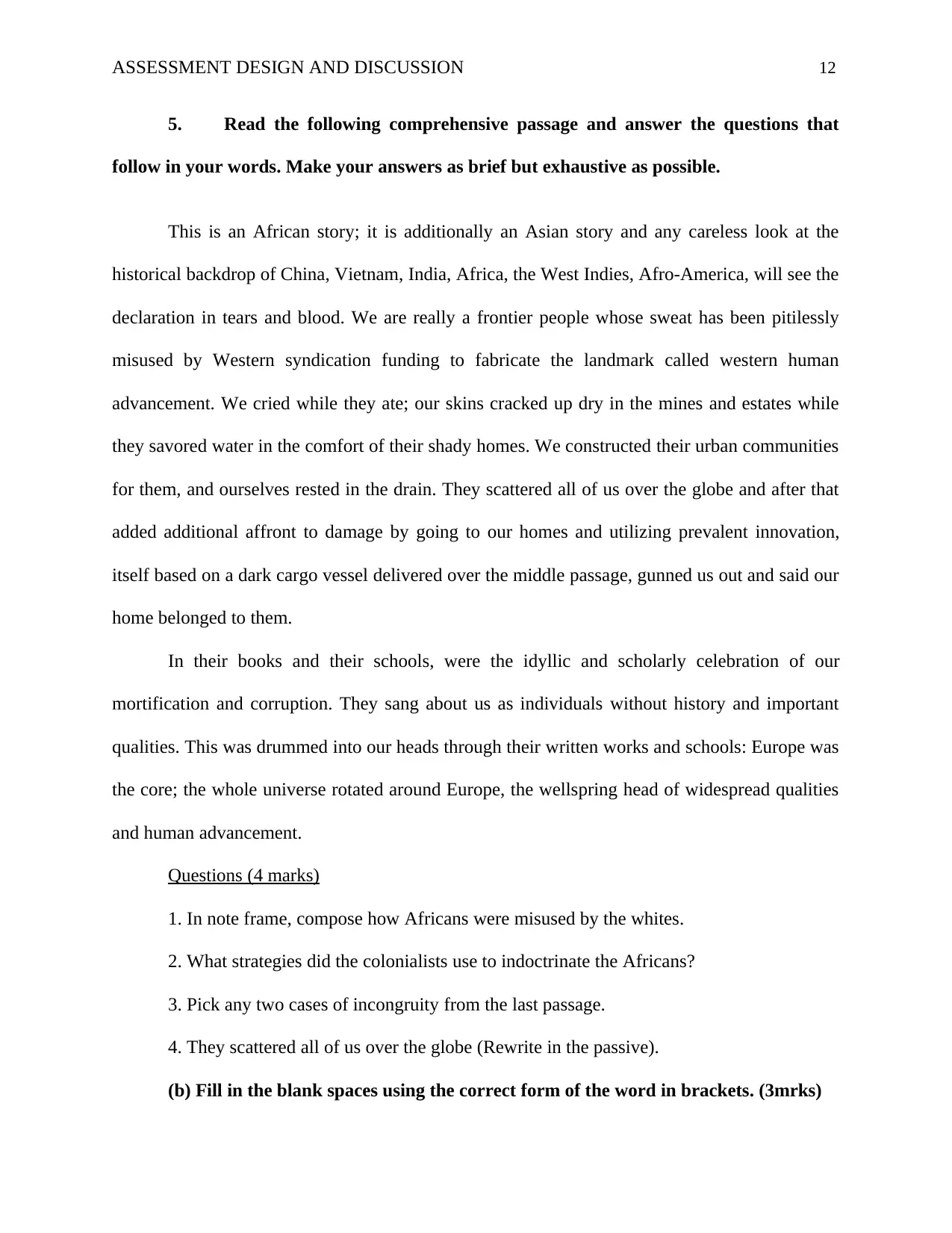
ASSESSMENT DESIGN AND DISCUSSION 12
5. Read the following comprehensive passage and answer the questions that
follow in your words. Make your answers as brief but exhaustive as possible.
This is an African story; it is additionally an Asian story and any careless look at the
historical backdrop of China, Vietnam, India, Africa, the West Indies, Afro-America, will see the
declaration in tears and blood. We are really a frontier people whose sweat has been pitilessly
misused by Western syndication funding to fabricate the landmark called western human
advancement. We cried while they ate; our skins cracked up dry in the mines and estates while
they savored water in the comfort of their shady homes. We constructed their urban communities
for them, and ourselves rested in the drain. They scattered all of us over the globe and after that
added additional affront to damage by going to our homes and utilizing prevalent innovation,
itself based on a dark cargo vessel delivered over the middle passage, gunned us out and said our
home belonged to them.
In their books and their schools, were the idyllic and scholarly celebration of our
mortification and corruption. They sang about us as individuals without history and important
qualities. This was drummed into our heads through their written works and schools: Europe was
the core; the whole universe rotated around Europe, the wellspring head of widespread qualities
and human advancement.
Questions (4 marks)
1. In note frame, compose how Africans were misused by the whites.
2. What strategies did the colonialists use to indoctrinate the Africans?
3. Pick any two cases of incongruity from the last passage.
4. They scattered all of us over the globe (Rewrite in the passive).
(b) Fill in the blank spaces using the correct form of the word in brackets. (3mrks)
5. Read the following comprehensive passage and answer the questions that
follow in your words. Make your answers as brief but exhaustive as possible.
This is an African story; it is additionally an Asian story and any careless look at the
historical backdrop of China, Vietnam, India, Africa, the West Indies, Afro-America, will see the
declaration in tears and blood. We are really a frontier people whose sweat has been pitilessly
misused by Western syndication funding to fabricate the landmark called western human
advancement. We cried while they ate; our skins cracked up dry in the mines and estates while
they savored water in the comfort of their shady homes. We constructed their urban communities
for them, and ourselves rested in the drain. They scattered all of us over the globe and after that
added additional affront to damage by going to our homes and utilizing prevalent innovation,
itself based on a dark cargo vessel delivered over the middle passage, gunned us out and said our
home belonged to them.
In their books and their schools, were the idyllic and scholarly celebration of our
mortification and corruption. They sang about us as individuals without history and important
qualities. This was drummed into our heads through their written works and schools: Europe was
the core; the whole universe rotated around Europe, the wellspring head of widespread qualities
and human advancement.
Questions (4 marks)
1. In note frame, compose how Africans were misused by the whites.
2. What strategies did the colonialists use to indoctrinate the Africans?
3. Pick any two cases of incongruity from the last passage.
4. They scattered all of us over the globe (Rewrite in the passive).
(b) Fill in the blank spaces using the correct form of the word in brackets. (3mrks)
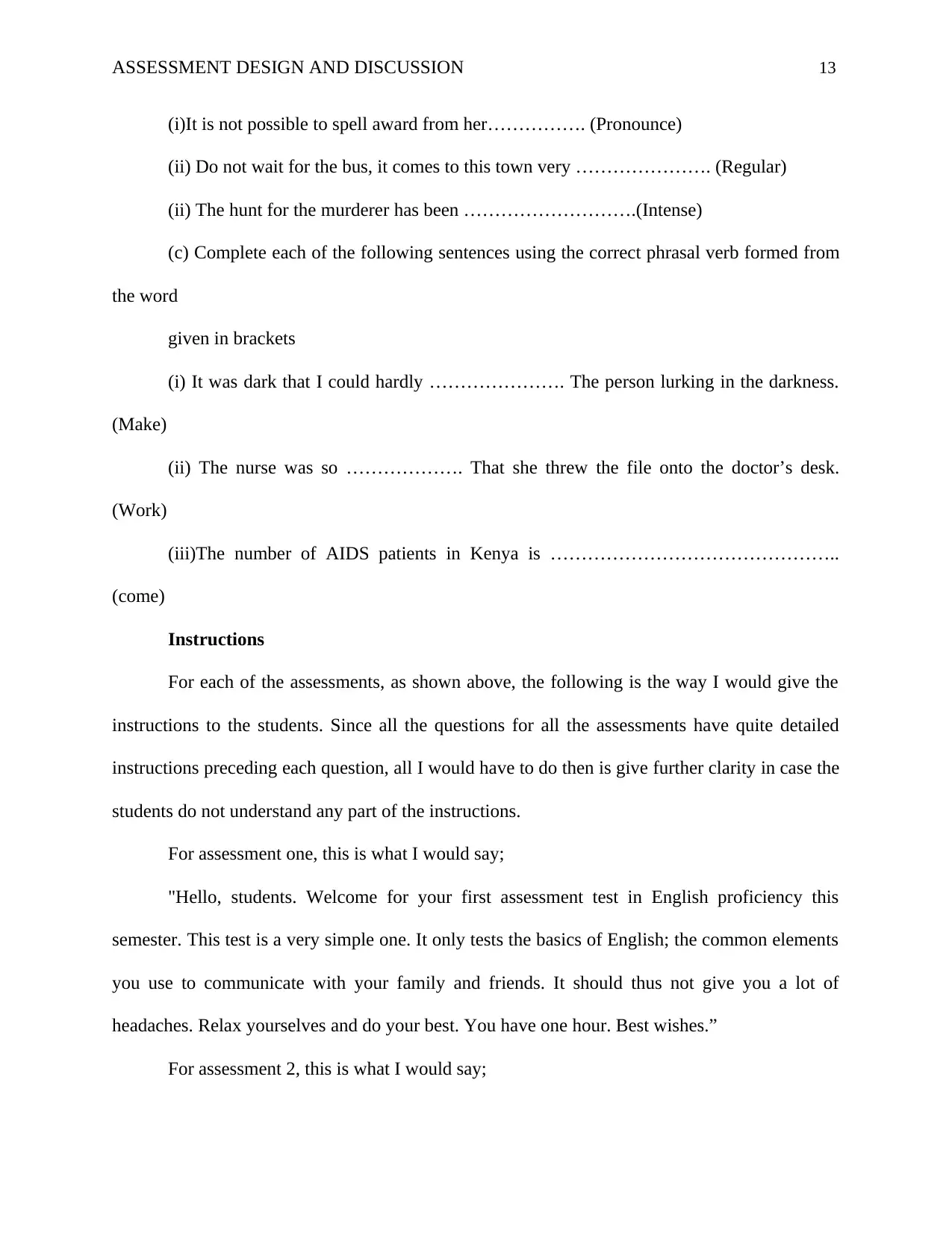
ASSESSMENT DESIGN AND DISCUSSION 13
(i)It is not possible to spell award from her……………. (Pronounce)
(ii) Do not wait for the bus, it comes to this town very …………………. (Regular)
(ii) The hunt for the murderer has been ……………………….(Intense)
(c) Complete each of the following sentences using the correct phrasal verb formed from
the word
given in brackets
(i) It was dark that I could hardly …………………. The person lurking in the darkness.
(Make)
(ii) The nurse was so ………………. That she threw the file onto the doctor’s desk.
(Work)
(iii)The number of AIDS patients in Kenya is ………………………………………..
(come)
Instructions
For each of the assessments, as shown above, the following is the way I would give the
instructions to the students. Since all the questions for all the assessments have quite detailed
instructions preceding each question, all I would have to do then is give further clarity in case the
students do not understand any part of the instructions.
For assessment one, this is what I would say;
"Hello, students. Welcome for your first assessment test in English proficiency this
semester. This test is a very simple one. It only tests the basics of English; the common elements
you use to communicate with your family and friends. It should thus not give you a lot of
headaches. Relax yourselves and do your best. You have one hour. Best wishes.”
For assessment 2, this is what I would say;
(i)It is not possible to spell award from her……………. (Pronounce)
(ii) Do not wait for the bus, it comes to this town very …………………. (Regular)
(ii) The hunt for the murderer has been ……………………….(Intense)
(c) Complete each of the following sentences using the correct phrasal verb formed from
the word
given in brackets
(i) It was dark that I could hardly …………………. The person lurking in the darkness.
(Make)
(ii) The nurse was so ………………. That she threw the file onto the doctor’s desk.
(Work)
(iii)The number of AIDS patients in Kenya is ………………………………………..
(come)
Instructions
For each of the assessments, as shown above, the following is the way I would give the
instructions to the students. Since all the questions for all the assessments have quite detailed
instructions preceding each question, all I would have to do then is give further clarity in case the
students do not understand any part of the instructions.
For assessment one, this is what I would say;
"Hello, students. Welcome for your first assessment test in English proficiency this
semester. This test is a very simple one. It only tests the basics of English; the common elements
you use to communicate with your family and friends. It should thus not give you a lot of
headaches. Relax yourselves and do your best. You have one hour. Best wishes.”
For assessment 2, this is what I would say;
Paraphrase This Document
Need a fresh take? Get an instant paraphrase of this document with our AI Paraphraser
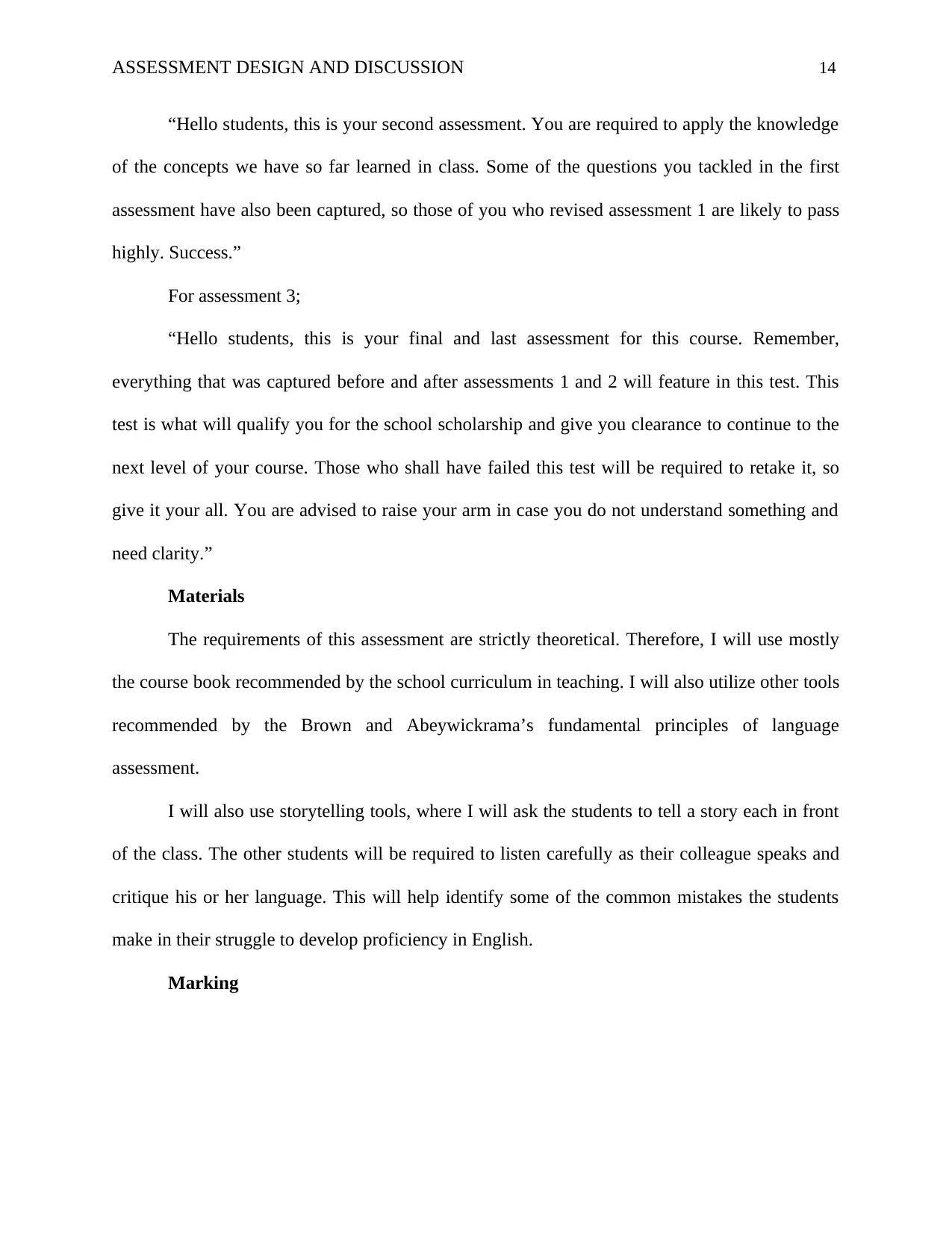
ASSESSMENT DESIGN AND DISCUSSION 14
“Hello students, this is your second assessment. You are required to apply the knowledge
of the concepts we have so far learned in class. Some of the questions you tackled in the first
assessment have also been captured, so those of you who revised assessment 1 are likely to pass
highly. Success.”
For assessment 3;
“Hello students, this is your final and last assessment for this course. Remember,
everything that was captured before and after assessments 1 and 2 will feature in this test. This
test is what will qualify you for the school scholarship and give you clearance to continue to the
next level of your course. Those who shall have failed this test will be required to retake it, so
give it your all. You are advised to raise your arm in case you do not understand something and
need clarity.”
Materials
The requirements of this assessment are strictly theoretical. Therefore, I will use mostly
the course book recommended by the school curriculum in teaching. I will also utilize other tools
recommended by the Brown and Abeywickrama’s fundamental principles of language
assessment.
I will also use storytelling tools, where I will ask the students to tell a story each in front
of the class. The other students will be required to listen carefully as their colleague speaks and
critique his or her language. This will help identify some of the common mistakes the students
make in their struggle to develop proficiency in English.
Marking
“Hello students, this is your second assessment. You are required to apply the knowledge
of the concepts we have so far learned in class. Some of the questions you tackled in the first
assessment have also been captured, so those of you who revised assessment 1 are likely to pass
highly. Success.”
For assessment 3;
“Hello students, this is your final and last assessment for this course. Remember,
everything that was captured before and after assessments 1 and 2 will feature in this test. This
test is what will qualify you for the school scholarship and give you clearance to continue to the
next level of your course. Those who shall have failed this test will be required to retake it, so
give it your all. You are advised to raise your arm in case you do not understand something and
need clarity.”
Materials
The requirements of this assessment are strictly theoretical. Therefore, I will use mostly
the course book recommended by the school curriculum in teaching. I will also utilize other tools
recommended by the Brown and Abeywickrama’s fundamental principles of language
assessment.
I will also use storytelling tools, where I will ask the students to tell a story each in front
of the class. The other students will be required to listen carefully as their colleague speaks and
critique his or her language. This will help identify some of the common mistakes the students
make in their struggle to develop proficiency in English.
Marking
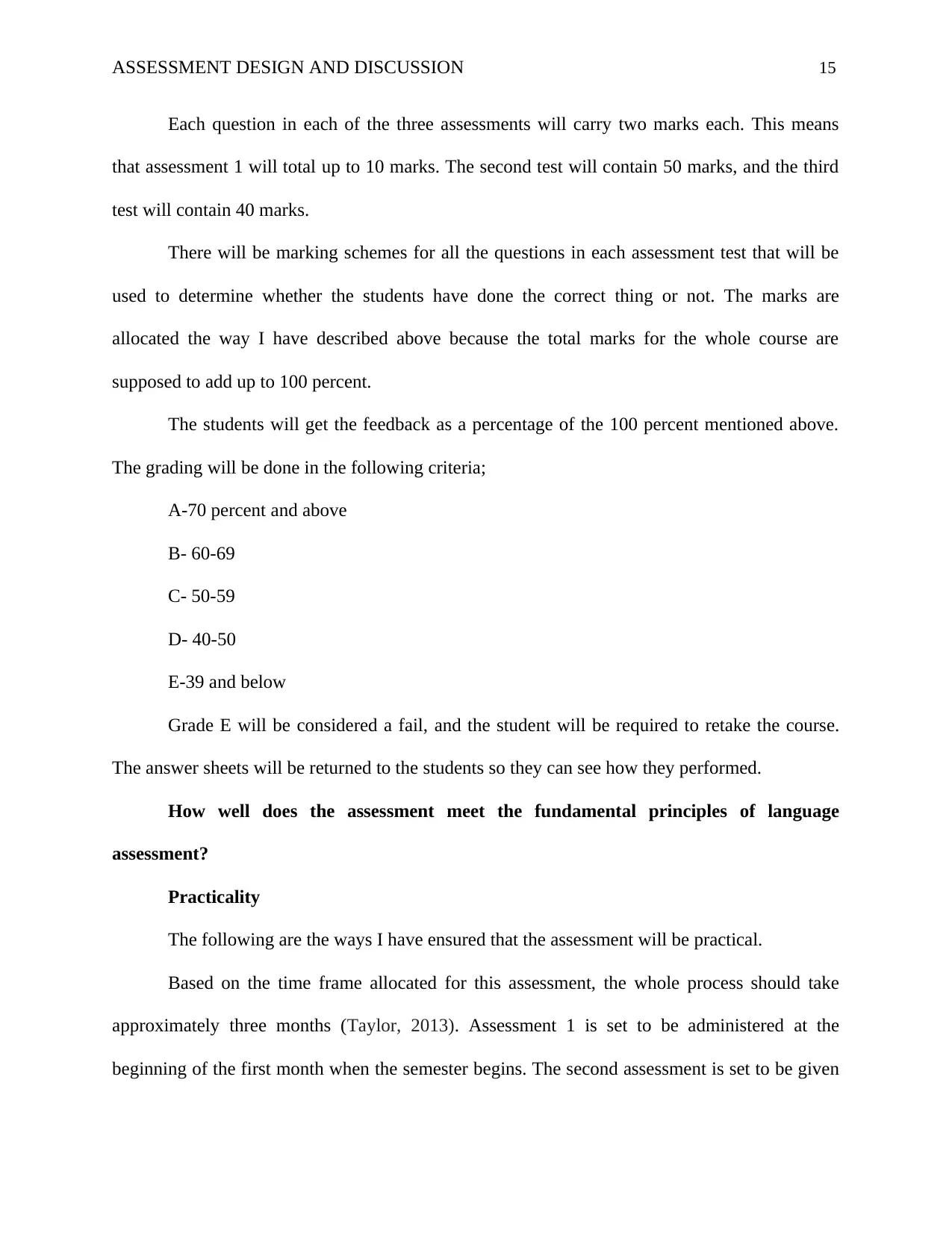
ASSESSMENT DESIGN AND DISCUSSION 15
Each question in each of the three assessments will carry two marks each. This means
that assessment 1 will total up to 10 marks. The second test will contain 50 marks, and the third
test will contain 40 marks.
There will be marking schemes for all the questions in each assessment test that will be
used to determine whether the students have done the correct thing or not. The marks are
allocated the way I have described above because the total marks for the whole course are
supposed to add up to 100 percent.
The students will get the feedback as a percentage of the 100 percent mentioned above.
The grading will be done in the following criteria;
A-70 percent and above
B- 60-69
C- 50-59
D- 40-50
E-39 and below
Grade E will be considered a fail, and the student will be required to retake the course.
The answer sheets will be returned to the students so they can see how they performed.
How well does the assessment meet the fundamental principles of language
assessment?
Practicality
The following are the ways I have ensured that the assessment will be practical.
Based on the time frame allocated for this assessment, the whole process should take
approximately three months (Taylor, 2013). Assessment 1 is set to be administered at the
beginning of the first month when the semester begins. The second assessment is set to be given
Each question in each of the three assessments will carry two marks each. This means
that assessment 1 will total up to 10 marks. The second test will contain 50 marks, and the third
test will contain 40 marks.
There will be marking schemes for all the questions in each assessment test that will be
used to determine whether the students have done the correct thing or not. The marks are
allocated the way I have described above because the total marks for the whole course are
supposed to add up to 100 percent.
The students will get the feedback as a percentage of the 100 percent mentioned above.
The grading will be done in the following criteria;
A-70 percent and above
B- 60-69
C- 50-59
D- 40-50
E-39 and below
Grade E will be considered a fail, and the student will be required to retake the course.
The answer sheets will be returned to the students so they can see how they performed.
How well does the assessment meet the fundamental principles of language
assessment?
Practicality
The following are the ways I have ensured that the assessment will be practical.
Based on the time frame allocated for this assessment, the whole process should take
approximately three months (Taylor, 2013). Assessment 1 is set to be administered at the
beginning of the first month when the semester begins. The second assessment is set to be given
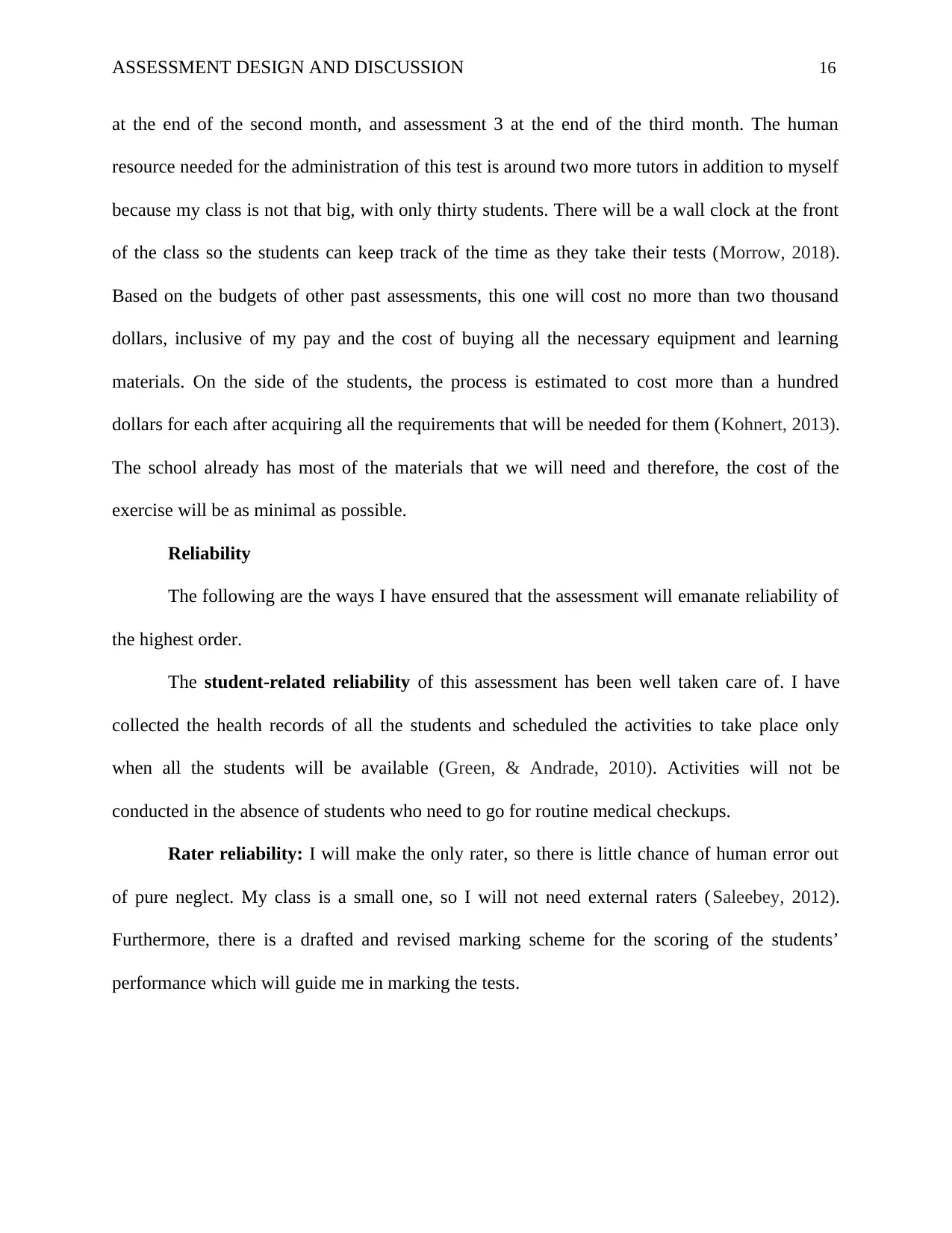
ASSESSMENT DESIGN AND DISCUSSION 16
at the end of the second month, and assessment 3 at the end of the third month. The human
resource needed for the administration of this test is around two more tutors in addition to myself
because my class is not that big, with only thirty students. There will be a wall clock at the front
of the class so the students can keep track of the time as they take their tests (Morrow, 2018).
Based on the budgets of other past assessments, this one will cost no more than two thousand
dollars, inclusive of my pay and the cost of buying all the necessary equipment and learning
materials. On the side of the students, the process is estimated to cost more than a hundred
dollars for each after acquiring all the requirements that will be needed for them (Kohnert, 2013).
The school already has most of the materials that we will need and therefore, the cost of the
exercise will be as minimal as possible.
Reliability
The following are the ways I have ensured that the assessment will emanate reliability of
the highest order.
The student-related reliability of this assessment has been well taken care of. I have
collected the health records of all the students and scheduled the activities to take place only
when all the students will be available (Green, & Andrade, 2010). Activities will not be
conducted in the absence of students who need to go for routine medical checkups.
Rater reliability: I will make the only rater, so there is little chance of human error out
of pure neglect. My class is a small one, so I will not need external raters (Saleebey, 2012).
Furthermore, there is a drafted and revised marking scheme for the scoring of the students’
performance which will guide me in marking the tests.
at the end of the second month, and assessment 3 at the end of the third month. The human
resource needed for the administration of this test is around two more tutors in addition to myself
because my class is not that big, with only thirty students. There will be a wall clock at the front
of the class so the students can keep track of the time as they take their tests (Morrow, 2018).
Based on the budgets of other past assessments, this one will cost no more than two thousand
dollars, inclusive of my pay and the cost of buying all the necessary equipment and learning
materials. On the side of the students, the process is estimated to cost more than a hundred
dollars for each after acquiring all the requirements that will be needed for them (Kohnert, 2013).
The school already has most of the materials that we will need and therefore, the cost of the
exercise will be as minimal as possible.
Reliability
The following are the ways I have ensured that the assessment will emanate reliability of
the highest order.
The student-related reliability of this assessment has been well taken care of. I have
collected the health records of all the students and scheduled the activities to take place only
when all the students will be available (Green, & Andrade, 2010). Activities will not be
conducted in the absence of students who need to go for routine medical checkups.
Rater reliability: I will make the only rater, so there is little chance of human error out
of pure neglect. My class is a small one, so I will not need external raters (Saleebey, 2012).
Furthermore, there is a drafted and revised marking scheme for the scoring of the students’
performance which will guide me in marking the tests.
Secure Best Marks with AI Grader
Need help grading? Try our AI Grader for instant feedback on your assignments.
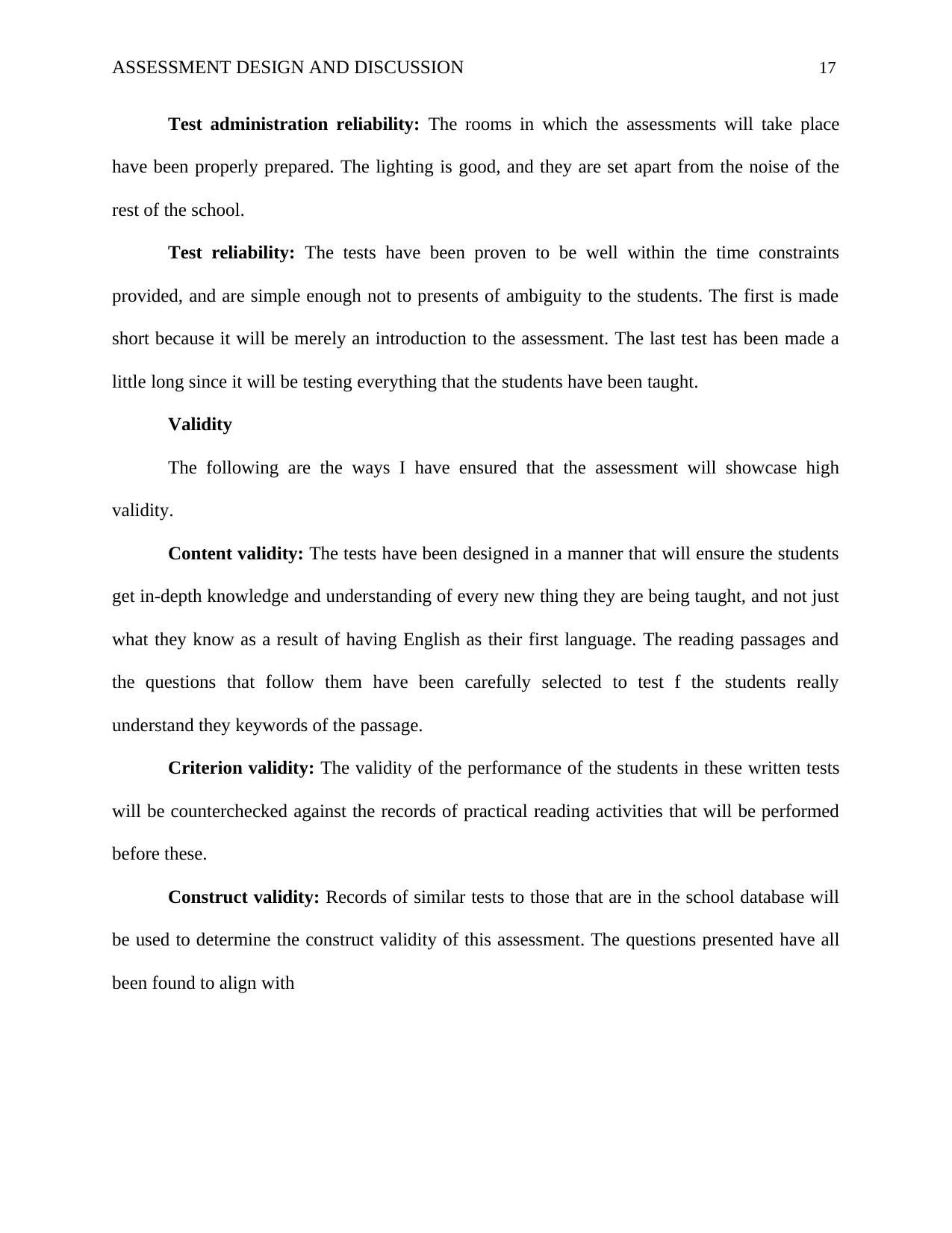
ASSESSMENT DESIGN AND DISCUSSION 17
Test administration reliability: The rooms in which the assessments will take place
have been properly prepared. The lighting is good, and they are set apart from the noise of the
rest of the school.
Test reliability: The tests have been proven to be well within the time constraints
provided, and are simple enough not to presents of ambiguity to the students. The first is made
short because it will be merely an introduction to the assessment. The last test has been made a
little long since it will be testing everything that the students have been taught.
Validity
The following are the ways I have ensured that the assessment will showcase high
validity.
Content validity: The tests have been designed in a manner that will ensure the students
get in-depth knowledge and understanding of every new thing they are being taught, and not just
what they know as a result of having English as their first language. The reading passages and
the questions that follow them have been carefully selected to test f the students really
understand they keywords of the passage.
Criterion validity: The validity of the performance of the students in these written tests
will be counterchecked against the records of practical reading activities that will be performed
before these.
Construct validity: Records of similar tests to those that are in the school database will
be used to determine the construct validity of this assessment. The questions presented have all
been found to align with
Test administration reliability: The rooms in which the assessments will take place
have been properly prepared. The lighting is good, and they are set apart from the noise of the
rest of the school.
Test reliability: The tests have been proven to be well within the time constraints
provided, and are simple enough not to presents of ambiguity to the students. The first is made
short because it will be merely an introduction to the assessment. The last test has been made a
little long since it will be testing everything that the students have been taught.
Validity
The following are the ways I have ensured that the assessment will showcase high
validity.
Content validity: The tests have been designed in a manner that will ensure the students
get in-depth knowledge and understanding of every new thing they are being taught, and not just
what they know as a result of having English as their first language. The reading passages and
the questions that follow them have been carefully selected to test f the students really
understand they keywords of the passage.
Criterion validity: The validity of the performance of the students in these written tests
will be counterchecked against the records of practical reading activities that will be performed
before these.
Construct validity: Records of similar tests to those that are in the school database will
be used to determine the construct validity of this assessment. The questions presented have all
been found to align with
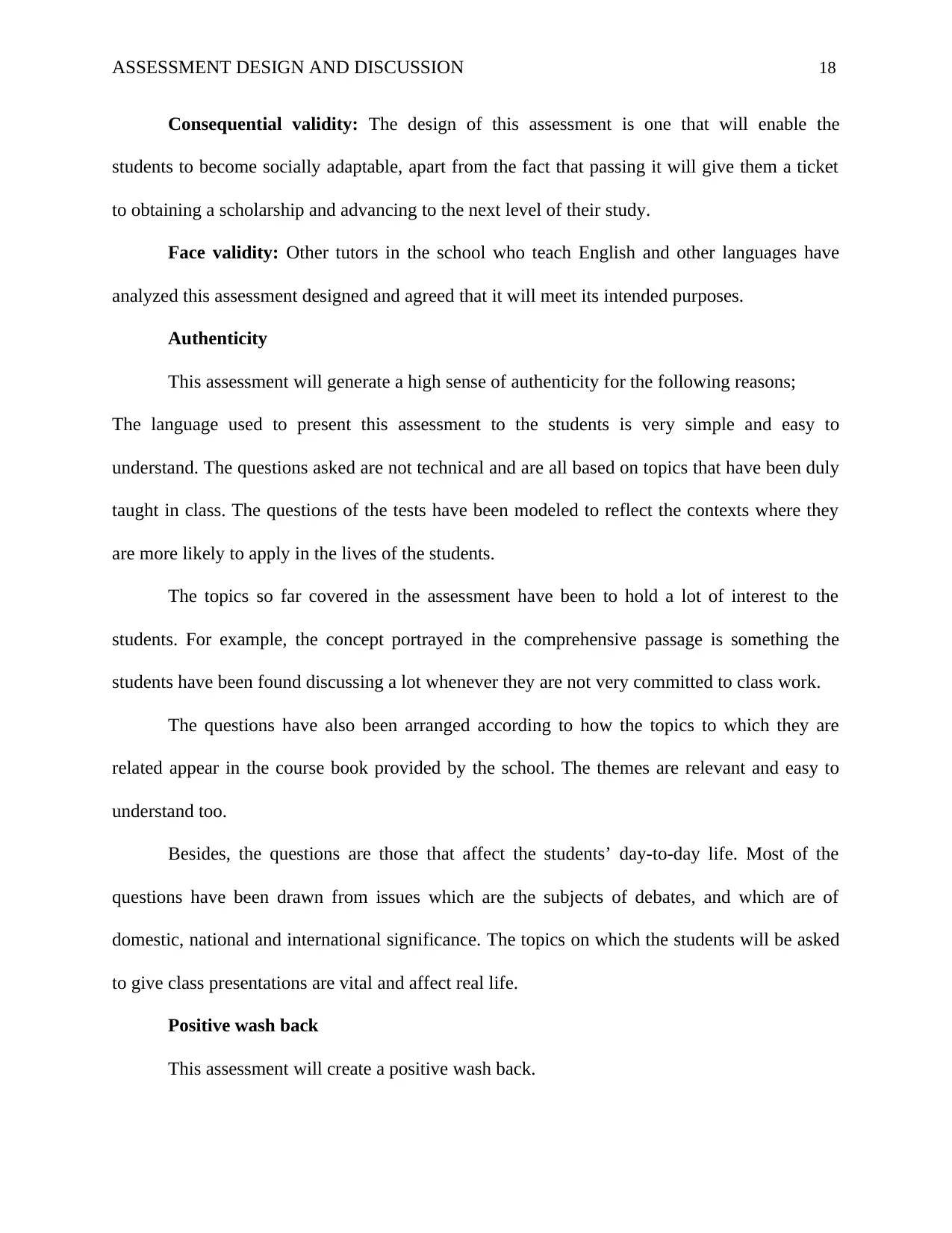
ASSESSMENT DESIGN AND DISCUSSION 18
Consequential validity: The design of this assessment is one that will enable the
students to become socially adaptable, apart from the fact that passing it will give them a ticket
to obtaining a scholarship and advancing to the next level of their study.
Face validity: Other tutors in the school who teach English and other languages have
analyzed this assessment designed and agreed that it will meet its intended purposes.
Authenticity
This assessment will generate a high sense of authenticity for the following reasons;
The language used to present this assessment to the students is very simple and easy to
understand. The questions asked are not technical and are all based on topics that have been duly
taught in class. The questions of the tests have been modeled to reflect the contexts where they
are more likely to apply in the lives of the students.
The topics so far covered in the assessment have been to hold a lot of interest to the
students. For example, the concept portrayed in the comprehensive passage is something the
students have been found discussing a lot whenever they are not very committed to class work.
The questions have also been arranged according to how the topics to which they are
related appear in the course book provided by the school. The themes are relevant and easy to
understand too.
Besides, the questions are those that affect the students’ day-to-day life. Most of the
questions have been drawn from issues which are the subjects of debates, and which are of
domestic, national and international significance. The topics on which the students will be asked
to give class presentations are vital and affect real life.
Positive wash back
This assessment will create a positive wash back.
Consequential validity: The design of this assessment is one that will enable the
students to become socially adaptable, apart from the fact that passing it will give them a ticket
to obtaining a scholarship and advancing to the next level of their study.
Face validity: Other tutors in the school who teach English and other languages have
analyzed this assessment designed and agreed that it will meet its intended purposes.
Authenticity
This assessment will generate a high sense of authenticity for the following reasons;
The language used to present this assessment to the students is very simple and easy to
understand. The questions asked are not technical and are all based on topics that have been duly
taught in class. The questions of the tests have been modeled to reflect the contexts where they
are more likely to apply in the lives of the students.
The topics so far covered in the assessment have been to hold a lot of interest to the
students. For example, the concept portrayed in the comprehensive passage is something the
students have been found discussing a lot whenever they are not very committed to class work.
The questions have also been arranged according to how the topics to which they are
related appear in the course book provided by the school. The themes are relevant and easy to
understand too.
Besides, the questions are those that affect the students’ day-to-day life. Most of the
questions have been drawn from issues which are the subjects of debates, and which are of
domestic, national and international significance. The topics on which the students will be asked
to give class presentations are vital and affect real life.
Positive wash back
This assessment will create a positive wash back.
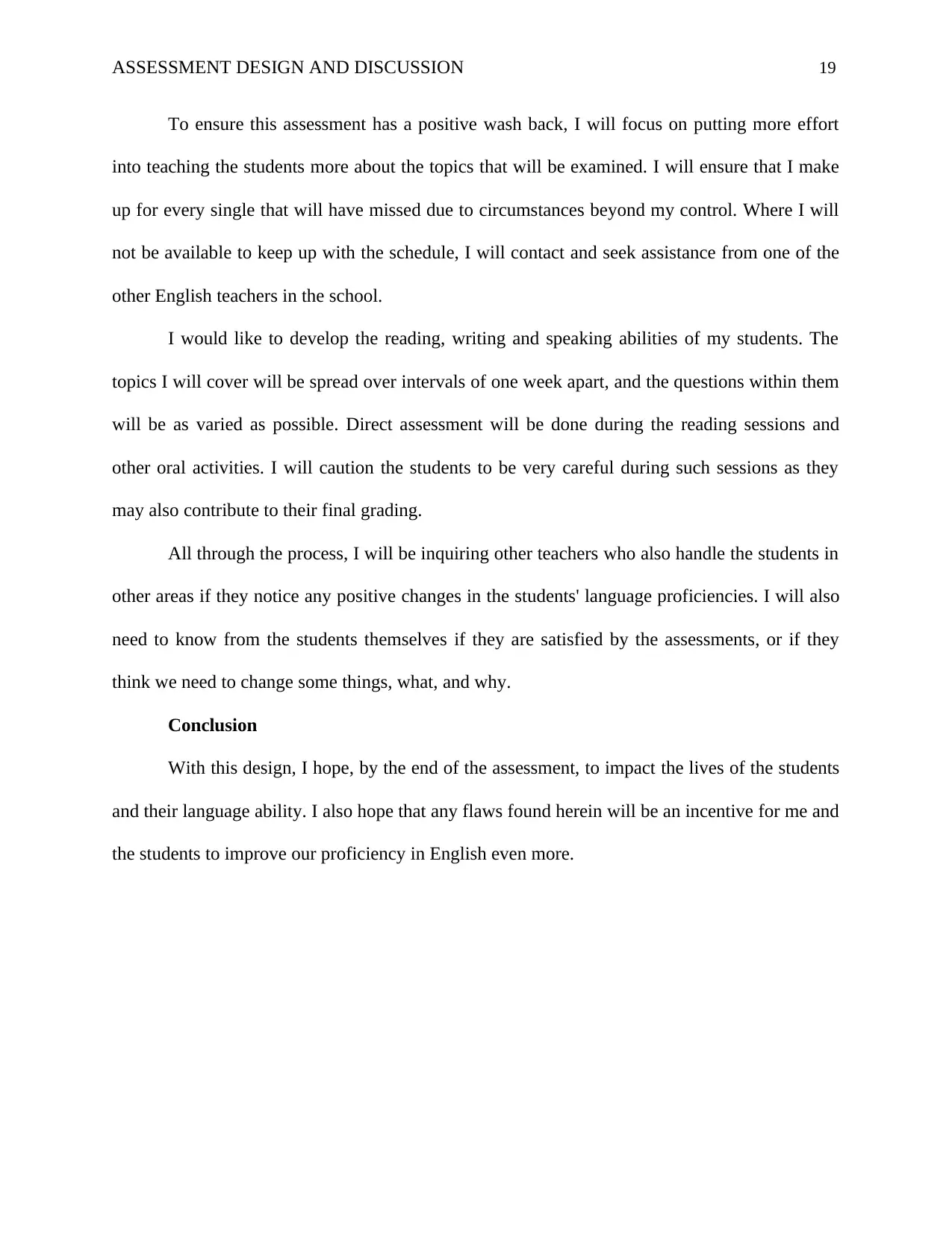
ASSESSMENT DESIGN AND DISCUSSION 19
To ensure this assessment has a positive wash back, I will focus on putting more effort
into teaching the students more about the topics that will be examined. I will ensure that I make
up for every single that will have missed due to circumstances beyond my control. Where I will
not be available to keep up with the schedule, I will contact and seek assistance from one of the
other English teachers in the school.
I would like to develop the reading, writing and speaking abilities of my students. The
topics I will cover will be spread over intervals of one week apart, and the questions within them
will be as varied as possible. Direct assessment will be done during the reading sessions and
other oral activities. I will caution the students to be very careful during such sessions as they
may also contribute to their final grading.
All through the process, I will be inquiring other teachers who also handle the students in
other areas if they notice any positive changes in the students' language proficiencies. I will also
need to know from the students themselves if they are satisfied by the assessments, or if they
think we need to change some things, what, and why.
Conclusion
With this design, I hope, by the end of the assessment, to impact the lives of the students
and their language ability. I also hope that any flaws found herein will be an incentive for me and
the students to improve our proficiency in English even more.
To ensure this assessment has a positive wash back, I will focus on putting more effort
into teaching the students more about the topics that will be examined. I will ensure that I make
up for every single that will have missed due to circumstances beyond my control. Where I will
not be available to keep up with the schedule, I will contact and seek assistance from one of the
other English teachers in the school.
I would like to develop the reading, writing and speaking abilities of my students. The
topics I will cover will be spread over intervals of one week apart, and the questions within them
will be as varied as possible. Direct assessment will be done during the reading sessions and
other oral activities. I will caution the students to be very careful during such sessions as they
may also contribute to their final grading.
All through the process, I will be inquiring other teachers who also handle the students in
other areas if they notice any positive changes in the students' language proficiencies. I will also
need to know from the students themselves if they are satisfied by the assessments, or if they
think we need to change some things, what, and why.
Conclusion
With this design, I hope, by the end of the assessment, to impact the lives of the students
and their language ability. I also hope that any flaws found herein will be an incentive for me and
the students to improve our proficiency in English even more.
Paraphrase This Document
Need a fresh take? Get an instant paraphrase of this document with our AI Paraphraser
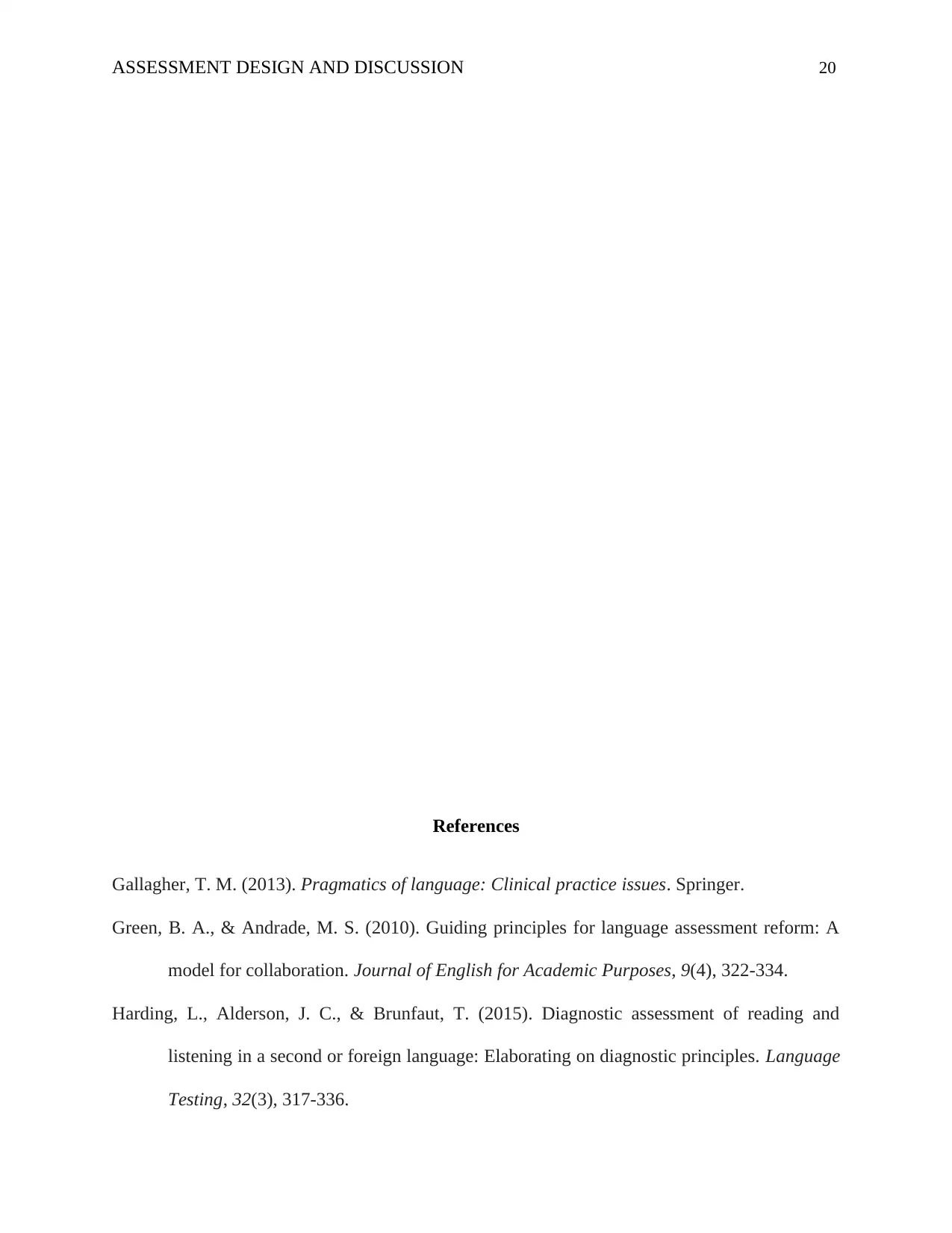
ASSESSMENT DESIGN AND DISCUSSION 20
References
Gallagher, T. M. (2013). Pragmatics of language: Clinical practice issues. Springer.
Green, B. A., & Andrade, M. S. (2010). Guiding principles for language assessment reform: A
model for collaboration. Journal of English for Academic Purposes, 9(4), 322-334.
Harding, L., Alderson, J. C., & Brunfaut, T. (2015). Diagnostic assessment of reading and
listening in a second or foreign language: Elaborating on diagnostic principles. Language
Testing, 32(3), 317-336.
References
Gallagher, T. M. (2013). Pragmatics of language: Clinical practice issues. Springer.
Green, B. A., & Andrade, M. S. (2010). Guiding principles for language assessment reform: A
model for collaboration. Journal of English for Academic Purposes, 9(4), 322-334.
Harding, L., Alderson, J. C., & Brunfaut, T. (2015). Diagnostic assessment of reading and
listening in a second or foreign language: Elaborating on diagnostic principles. Language
Testing, 32(3), 317-336.
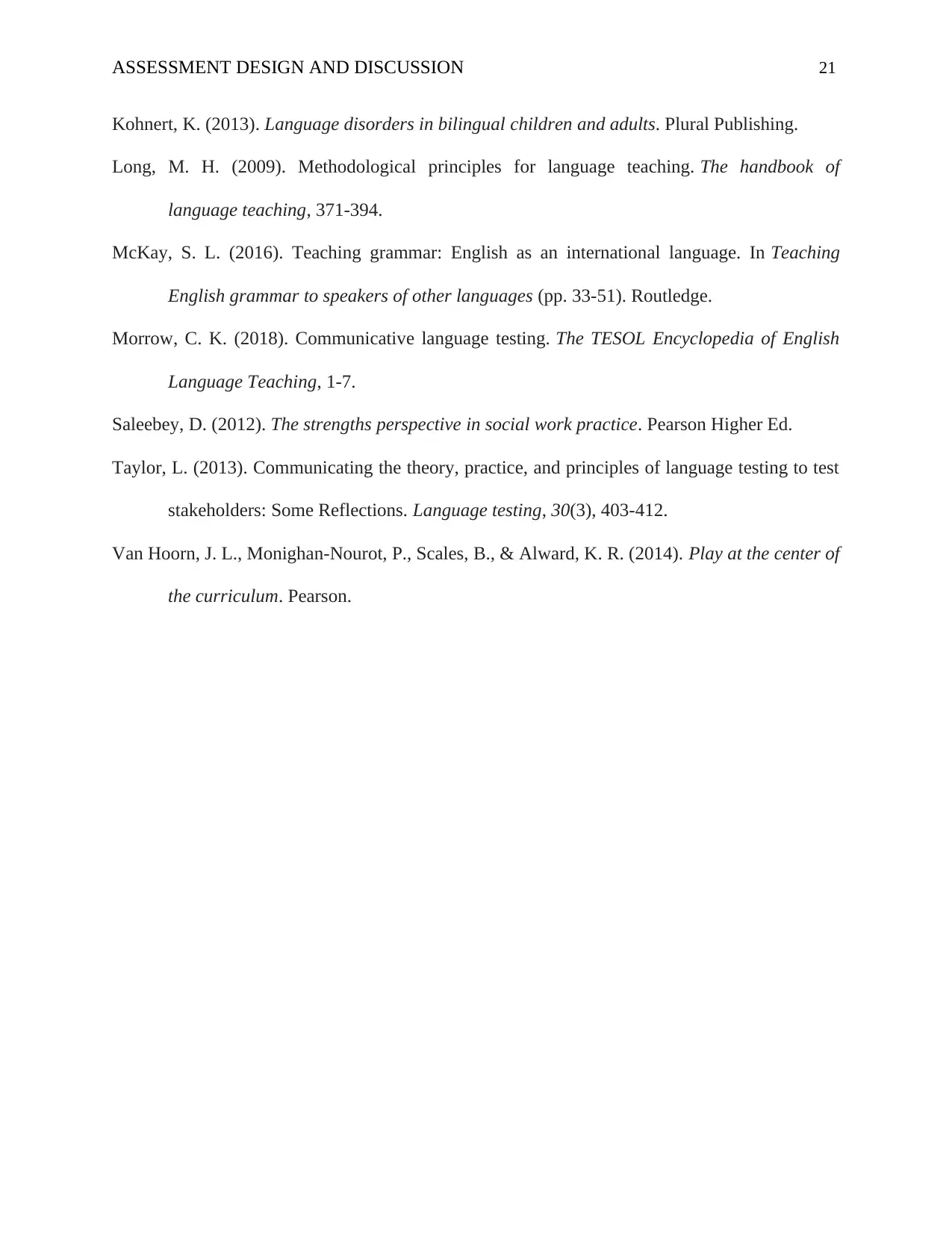
ASSESSMENT DESIGN AND DISCUSSION 21
Kohnert, K. (2013). Language disorders in bilingual children and adults. Plural Publishing.
Long, M. H. (2009). Methodological principles for language teaching. The handbook of
language teaching, 371-394.
McKay, S. L. (2016). Teaching grammar: English as an international language. In Teaching
English grammar to speakers of other languages (pp. 33-51). Routledge.
Morrow, C. K. (2018). Communicative language testing. The TESOL Encyclopedia of English
Language Teaching, 1-7.
Saleebey, D. (2012). The strengths perspective in social work practice. Pearson Higher Ed.
Taylor, L. (2013). Communicating the theory, practice, and principles of language testing to test
stakeholders: Some Reflections. Language testing, 30(3), 403-412.
Van Hoorn, J. L., Monighan-Nourot, P., Scales, B., & Alward, K. R. (2014). Play at the center of
the curriculum. Pearson.
Kohnert, K. (2013). Language disorders in bilingual children and adults. Plural Publishing.
Long, M. H. (2009). Methodological principles for language teaching. The handbook of
language teaching, 371-394.
McKay, S. L. (2016). Teaching grammar: English as an international language. In Teaching
English grammar to speakers of other languages (pp. 33-51). Routledge.
Morrow, C. K. (2018). Communicative language testing. The TESOL Encyclopedia of English
Language Teaching, 1-7.
Saleebey, D. (2012). The strengths perspective in social work practice. Pearson Higher Ed.
Taylor, L. (2013). Communicating the theory, practice, and principles of language testing to test
stakeholders: Some Reflections. Language testing, 30(3), 403-412.
Van Hoorn, J. L., Monighan-Nourot, P., Scales, B., & Alward, K. R. (2014). Play at the center of
the curriculum. Pearson.
1 out of 21
Related Documents
Your All-in-One AI-Powered Toolkit for Academic Success.
+13062052269
info@desklib.com
Available 24*7 on WhatsApp / Email
![[object Object]](/_next/static/media/star-bottom.7253800d.svg)
Unlock your academic potential
© 2024 | Zucol Services PVT LTD | All rights reserved.





